Forums
- Forums
- Axis And Allies Forum
- General Discussion
- Aviation News
Aviation News
Post a reply
- Go to Next topic
- Go to Welcome
- Go to Introduce Yourself
- Go to General Discussion
- Go to Screenshots, Images and Videos
- Go to Off topic
- Go to Works in Progress
- Go to Skinning Tips / Tutorials
- Go to Skin Requests
- Go to IJAAF Library
- Go to Luftwaffe Library
- Go to RAF Library
- Go to USAAF / USN Library
- Go to Misc Library
- Go to The Ops Room
- Go to Made in Germany
- Go to Campaigns and Missions
- Go to Works in Progress
- Go to Juri's Air-Raid Shelter
- Go to Campaigns and Missions
- Go to Works in Progress
- Go to Skinpacks
- Go to External Projects Discussion
- Go to Books & Resources
-
 Main Admin‘Talons out’ as 355th FS flies first official FHP sorties
Main Admin‘Talons out’ as 355th FS flies first official FHP sorties
An F-35A Lightning II assigned to the 355th Fighter Squadron flies over Eielson Air Force Base, Alaska, July 1, 2021. As one of the 354th Fighter Wing’s F-35A units, the 355th FS bolsters the 354th wing’s transition to a combat-coded mission, doubling U.S. Pacific Air Forces’ F-35A combat capability. (U.S. Air Force photo by Airman 1st Class Jose Miguel T. Tamondong)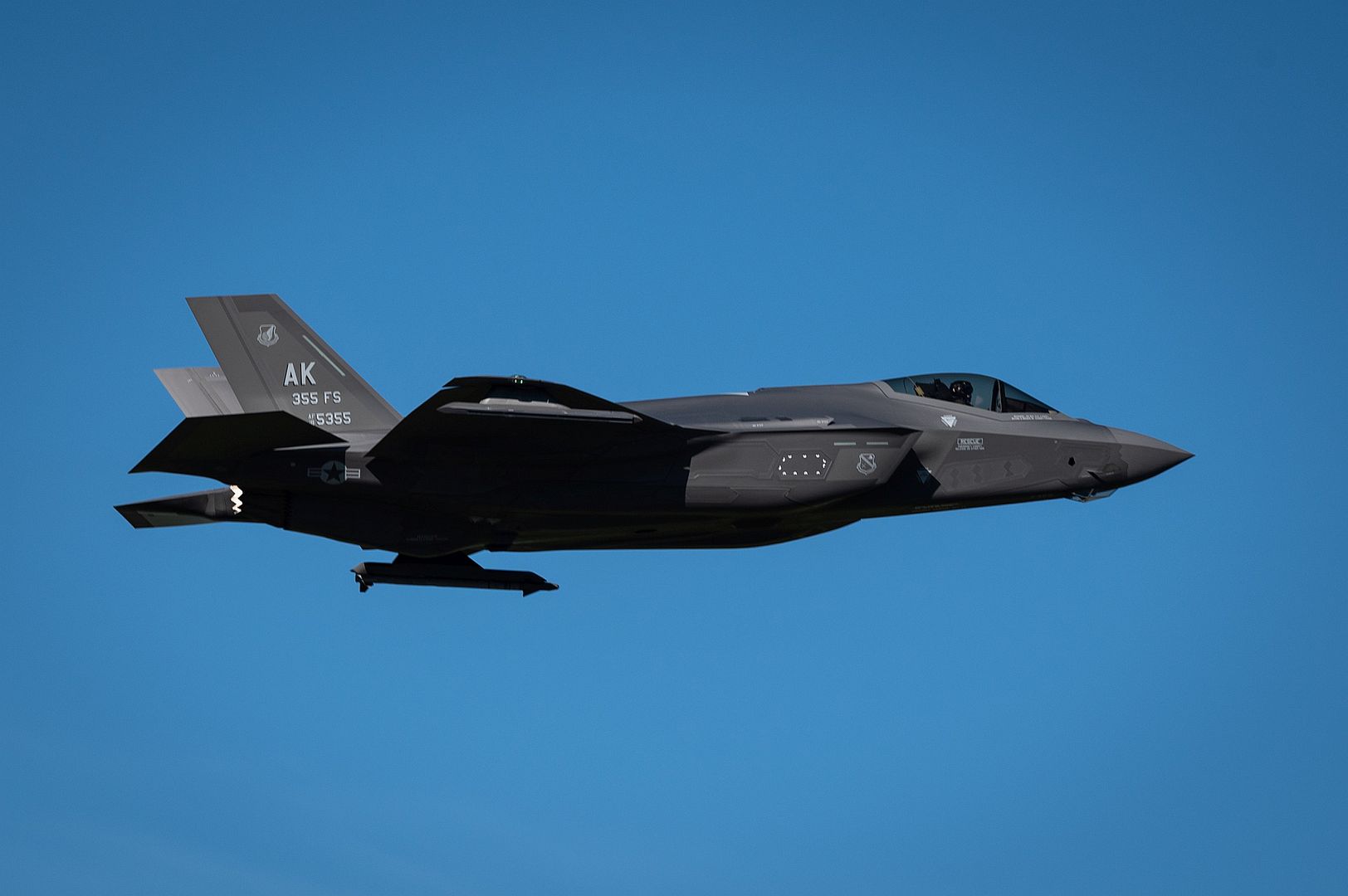
An F-35A Lightning II assigned to the 355th Fighter Squadron (FS) takes off from Eielson Air Force Base, Alaska, July 1, 2021. Also known as the ‘Fighting Falcons,’ the 355th FS is one of Eielson’s two combat-coded F-35A squadrons. (U.S. Air Force photo by Airman 1st Class Jose Miguel T. Tamondong)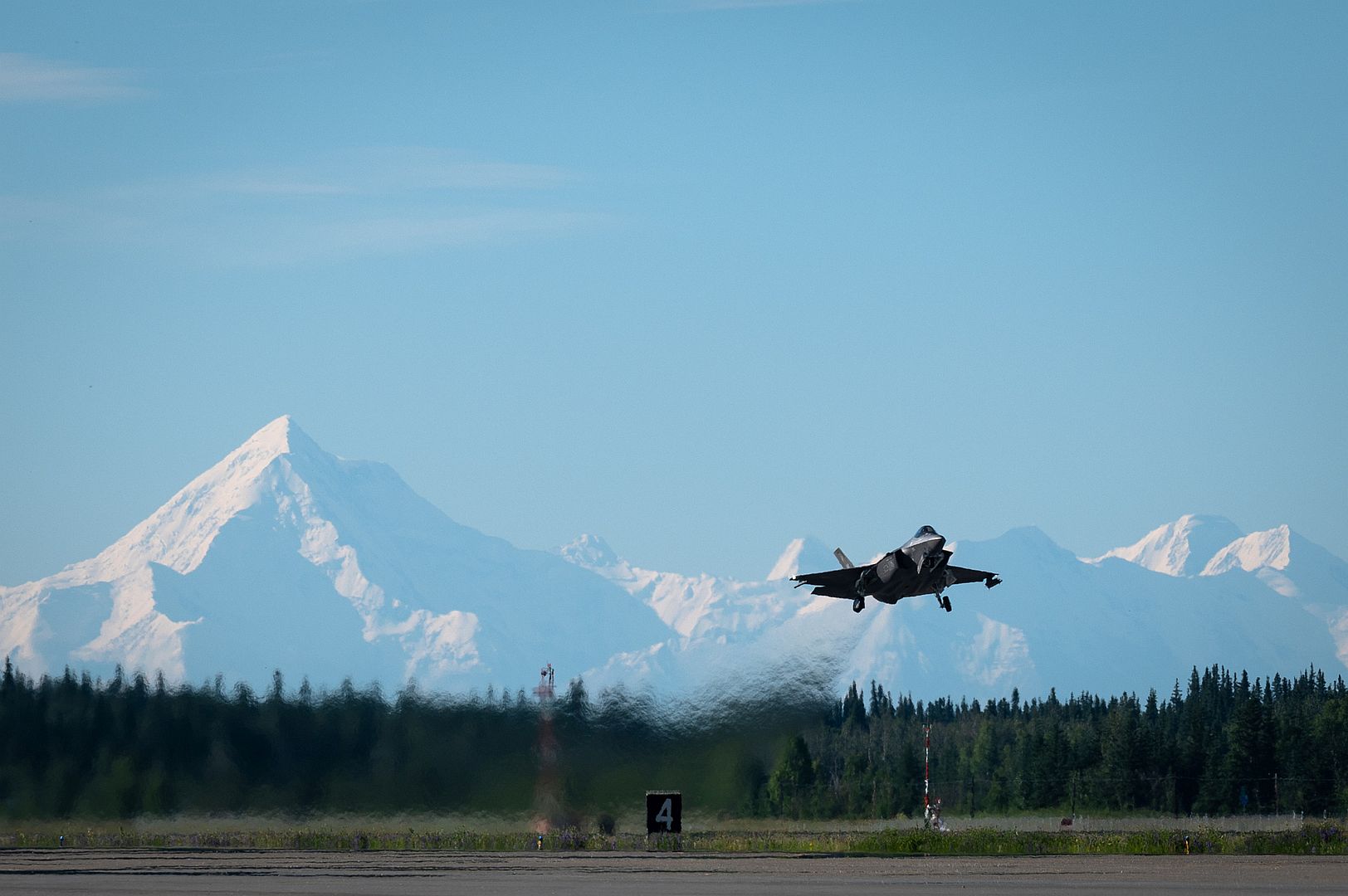
An F-15EX Eagle II sits in a line of other fighters waiting to take off to participate in Emerald Flag June 24 at Eglin Air Force Base, Fla. The EF aims to connect air, land, ground, sea, space and cyberspace systems to improve the speed and accessibility of information shared in a live and virtual battlefield. (U.S. Air Force photo/1st Lt. Karissa Rodriguez)
ATSUGI, Japan (June 30, 2021) Aviation Boatswain's Mate (Handling) 2nd Class Joann Sanesanong, assigned to the Naval Air Facility (NAF) Atsugi Air Operations Department, drives a Halvorsen loader to unload cargo off a C-40 Clipper following its arrival onboard the installation, June 30, 2021. NAF Atsugi supports the combat readiness of Commander, Fleet Air Forward (CFAF), Commander, Carrier Air Wing (CVW) 5, Helicopter Maritime Strike Squadron (HSM) 51 and 30 other tenant commands by providing logistic support, coordination and services to units assigned to the Western Pacific. (U.S. Navy photo by Mass Communication Specialist 3rd Class Rafael Avelar)
Col. John Gallemore, 8th Fighter Wing commander, flies an F-16 Fighting Falcon over Kunsan Air Base, Republic of Korea, June 29, 2021. Gallemore is the 61st wing commander at Kunsan Air Base, Republic of Korea, who previously served as the installation’s 80th Fighter Squadron commander in 2015. (U.S. Air Force photos by Staff Sgt. Mya M. Crosby)




An F-16 Fighting Falcon, assigned to the Ohio National Guard’s 180th Fighter Wing, carrying U.S. Army Maj. Gen. John Harris, The Adjutant General of the Ohio National Guard, sits on the flighline before a familiarization flight at the 180FW in Swanton, Ohio, June 29, 2021. Harris visited the 180FW for a familiarization flight to learn more about the 180FW mission, providing him a greater understanding of the 180FW’s capabilities.
(U.S. Air National Guard photos by Senior Airman Kregg York)

-
 Main AdminA U.S. Air Force E-3 Sentry Airborne Warning and Control System (AWACS) aircraft assigned to the 968th Expeditionary Airborne Air Control Squadron, takes off in support of a joint, multi-national exercise at Al Dhafra Air Base (ADAB), United Arab Emirates, June 30, 2021. During the exercises, multiple platforms worked together to execute and refine tactics, techniques and procedures to counter Unmanned Aerial System threats. Conducting consistent training with partner nations ensures interoperability and the ability to defend ourselves, and reinforces security and stability in the region. (U.S. Air Force photo by Master Sgt. Wolfram M. Stumpf)
Main AdminA U.S. Air Force E-3 Sentry Airborne Warning and Control System (AWACS) aircraft assigned to the 968th Expeditionary Airborne Air Control Squadron, takes off in support of a joint, multi-national exercise at Al Dhafra Air Base (ADAB), United Arab Emirates, June 30, 2021. During the exercises, multiple platforms worked together to execute and refine tactics, techniques and procedures to counter Unmanned Aerial System threats. Conducting consistent training with partner nations ensures interoperability and the ability to defend ourselves, and reinforces security and stability in the region. (U.S. Air Force photo by Master Sgt. Wolfram M. Stumpf)
A U.S. Air Force EC-130H Compass Call takes off from the flight line during a show-of-force readiness exercise at Davis-Monthan Air Force Base, Arizona, June 28, 2021. The 55th Electronic Combat Group executed this exercise using its seven EC-130H Compass Calls that taxied, took off and performed simulated combat sorties. (U.S. Air Force photo by Tech. Sgt. Sergio A. Gamboa)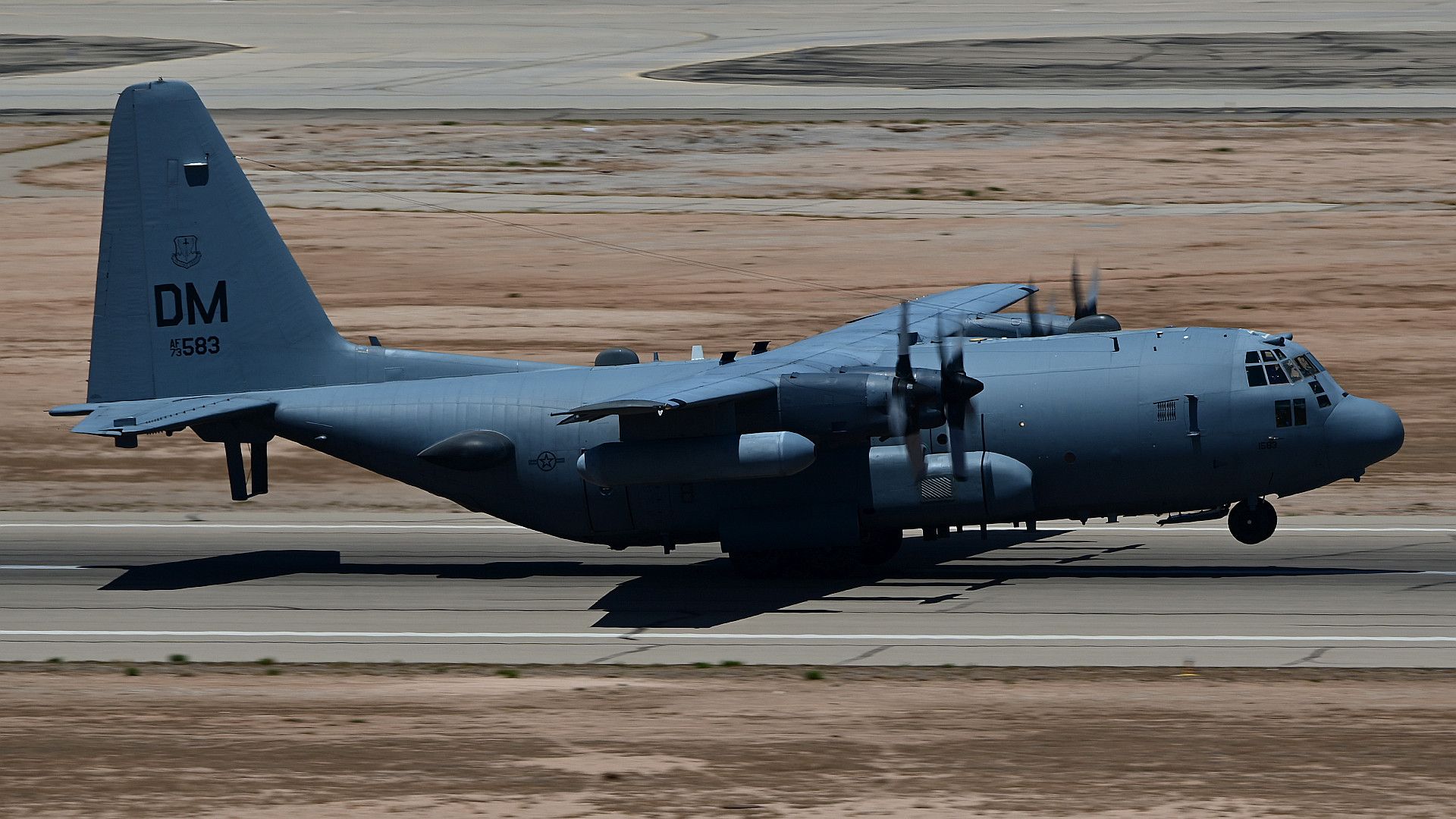
MYKOLAIV MILITARY AIRBASE, Ukraine (June 30, 2021) Two Ukrainian Mi-8 helicopters fly in formation during an air demonstration portion of Exercise Sea Breeze 2021 on Mykolaiv Military Airbase, Ukraine, June 30, 2021. Exercise Sea Breeze is a multinational maritime exercise cohosted by the U.S. Sixth Fleet and the Ukrainian Navy since 1997. Sea Breeze 2021 is designed to enhance interoperability of participating nations and strengthens maritime security and peace in the region. (U.S. Navy photo by Mass Communications Specialist 2nd Class Damon Grosvenor)
02.07.2021
Military transport Il-76 aircraft carried out training flights from the Migalovo airfield. Young officers from among the graduates of 2020 also took part in them.
The crews worked out take-off and landing at night, flying along a given route, interacting with the flight management group, as well as simulating a practical landing with the opening of the ramp and side doors.
Such night flights are conducted in order to maintain a high level of crew training, improve the skills of young flight personnel and prepare for flights at any time of the day at any airfields. In total, more than 10 military transport aircraft of the Aerospace Forces were involved.
(Photos courtesy of the Ministry of Defence of the Russian Federation)
2021/07/01
A third Falcon 6X recently took flight and joined Dassault Aviation’s flight test campaign, moving the new long-range extra widebody twin a step closer to anticipated certification in 2022.
Falcon 6X s/n 003 is fitted with a full interior and will be used for cabin design validation. The aircraft completed a two-hour maiden flight from Dassault’s Bordeaux-Mérignac final assembly plant to its Istres flight test facility on June 24, climbing to Flight Level 400 and accelerating to a cruise speed of Mach 0.85. The first 6X flew on March 10 and the second on April 30.
Aircraft no. 3 is outfitted with the Falcon 6X’s award winning interior, including in-flight entertainment and communications systems. In addition to testing this equipment, the aircraft will be used to evaluate environmental features and temperature control and validate cabin acoustics systems, which alongside those on the ultra long-range Falcon 8X trijet are expected to be the industry reference.
A fourth aircraft will also be equipped with a full cabin interior, currently being installed in Mérignac. It will conduct a two-month global endurance flight campaign intended to ensure that all 6X systems are fully mature upon entry into service.
Production of additional units is in full swing, with aircraft no. 10 scheduled to be on the final assembly line by beginning of July.
The Falcon 6X has received several prestigious design awards, including the Red Dot prize for premium cabin design. The aircraft was recognized this month as the “Best of the Best” in aviation by the Robb Report luxury-lifestyle magazine, which noted: “Dassault’s newest aircraft pairs size with technology to create an award-worthy new class of business jet.”
Air Marshal Gerry Mayhew, RAF Deputy Commander Operations, and Lieutenant General Ingo Gerhartz, the head of the German Air Force, have flown to Romania to visit 121 Expeditionary Air Wing who are currently conducting NATO enhanced Air Policing, together with the currently integrated German Eurofighter detachment.
Flying in an RAF Typhoon, Air Marshal Mayhew met up with Lieutenant General Gerhartz who was flying in a German Eurofighter. After tanking from a RAF Voyager, they landed in Romania to be greeted by Major General Victor Pana, the Chief of the Romanian Air Force.
The three senior officers observed the first ever live armed training scramble carried out by a RAF Typhoon, Luftwaffe Eurofighter and a Romanian Air Force Mig-21 LanceR.
(Photos courtesy of the RAF)
Puma HC Mk 2 XW224 flew its first flight in its new colours today – a unique paint scheme to commemorate 50 years of service by the Puma helicopter.
The paint scheme is similar to that of the first Puma HC Mk 1 helicopters that arrived in service with the Royal Air Force in 1971. However, there are several notable differences. This includes the engine housing boasting the badges of all the squadrons who have flown the Puma, the tail fin emblazoned with a union flag and the standard RAF logo on the cabin door being replaced by the bespoke RAF Puma 50 logo.
(Photos courtesy of the RAF)


-
 Main AdminARABIAN SEA (July 4, 2021) – An F/A-18E Super Hornet fighter jet, attached to the “Eagles” of Strike Fighter Squadron (VFA) 115, lands on the flight deck of aircraft carrier USS Ronald Reagan (CVN 76) during flight operations in the Arabian Sea, July 4. Ronald Reagan is the flagship for Carrier Strike Group 5, deployed to the U.S. 5th Fleet area of operations in support of naval operations to ensure maritime stability and security in the Central Region, connecting the Mediterranean and Pacific through the western Indian Ocean and three strategic choke points. (U.S. Navy photo by Mass Communication Specialist 2nd Class Samantha Jetzer)
Main AdminARABIAN SEA (July 4, 2021) – An F/A-18E Super Hornet fighter jet, attached to the “Eagles” of Strike Fighter Squadron (VFA) 115, lands on the flight deck of aircraft carrier USS Ronald Reagan (CVN 76) during flight operations in the Arabian Sea, July 4. Ronald Reagan is the flagship for Carrier Strike Group 5, deployed to the U.S. 5th Fleet area of operations in support of naval operations to ensure maritime stability and security in the Central Region, connecting the Mediterranean and Pacific through the western Indian Ocean and three strategic choke points. (U.S. Navy photo by Mass Communication Specialist 2nd Class Samantha Jetzer)
ARABIAN SEA (July 4, 2021) – An F/A-18E Super Hornet fighter jet, attached to the “Royal Maces” of Strike Fighter Squadron (VFA) 27, lands on the flight deck of aircraft carrier USS Ronald Reagan (CVN 76) during flight operations in the Arabian Sea, July 4. Ronald Reagan is the flagship for Carrier Strike Group 5, deployed to the U.S. 5th Fleet area of operations in support of naval operations to ensure maritime stability and security in the Central Region, connecting the Mediterranean and Pacific through the western Indian Ocean and three strategic choke points. (U.S. Navy photo by Mass Communication Specialist 2nd Class Samantha Jetzer)
An MC-130J Air Commando II flies off the coast of New South Wales, Australia during exercise Teak Action 21, July 3, 2021. Through strict COVID precautions, the 353rd Special Operations Group was able to train bilaterally with RAAF Airmen, sharing tactics and procedures to foster increased interoperability across the Indo-Pacific. (U.S. Air Force photo by 1st Lt. Joshua Thompson)
GARDNER, Kan. (July 3, 2021) Fireworks erupt after the U.S. Navy flight demonstration squadron, the Blue Angels, perform at New Century Air Center during the Kansas City Air Show, July 3, 2021. The Blue Angels are the headlining performing act at the air show and takes place during Kansas City Navy Week, the first in-person Navy Week since the beginning of the COVID-19 pandemic. The Blue Angels 2021 show season is their first year flying the Super Hornet platform as well as the team’s 75th anniversary. (U.S. Navy photo by Mass Communication Specialist 1st Class Chris Williamson)
-
 Main AdminU.S. Air Force Maj. Kristin "BEO" Wolfe, F-35A Lightning II Demonstration Team pilot and commander, flies over Commencement Bay as part of the 2021 Tacoma Freedom Fair, Wash., July 2, 2021. The F-35 Demo Team headlined both the Gig Harbor Wings-and-Wheels and Tacoma Freedom Fair air shows for the 4th of July weekend, showcasing the advanced capabilities of the F-35 to the Pacific Northwest. (U.S. Air Force photo by Capt. Kip Sumner)
Main AdminU.S. Air Force Maj. Kristin "BEO" Wolfe, F-35A Lightning II Demonstration Team pilot and commander, flies over Commencement Bay as part of the 2021 Tacoma Freedom Fair, Wash., July 2, 2021. The F-35 Demo Team headlined both the Gig Harbor Wings-and-Wheels and Tacoma Freedom Fair air shows for the 4th of July weekend, showcasing the advanced capabilities of the F-35 to the Pacific Northwest. (U.S. Air Force photo by Capt. Kip Sumner)
U.S. Air Force Maj. Kristin "BEO" Wolfe, F-35A Lightning II Demonstration Team pilot and commander, flies in formation with retired Lt. Col. Greg Anders, Air Force Heritage Flight Foundation P-51 pilot, over Tacoma's Commencement Bay, July 3, 2021. The F-35 Demo Team headlined both the 2021 Gig Harbor Wings-and-Wheels and Tacoma Freedom Fair air shows for the 4th of July weekend. (U.S. Air Force photos by Capt. Kip Sumner)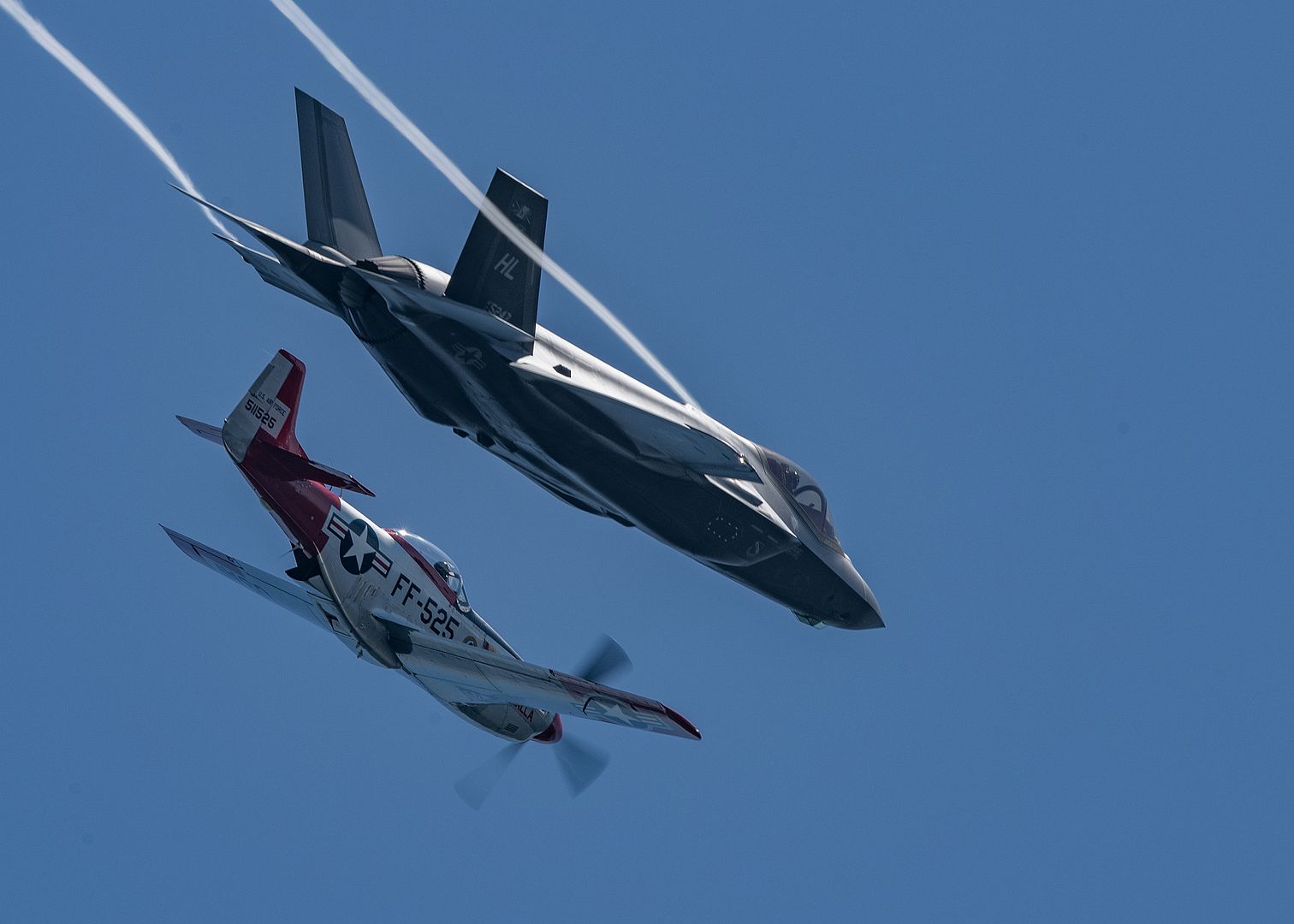
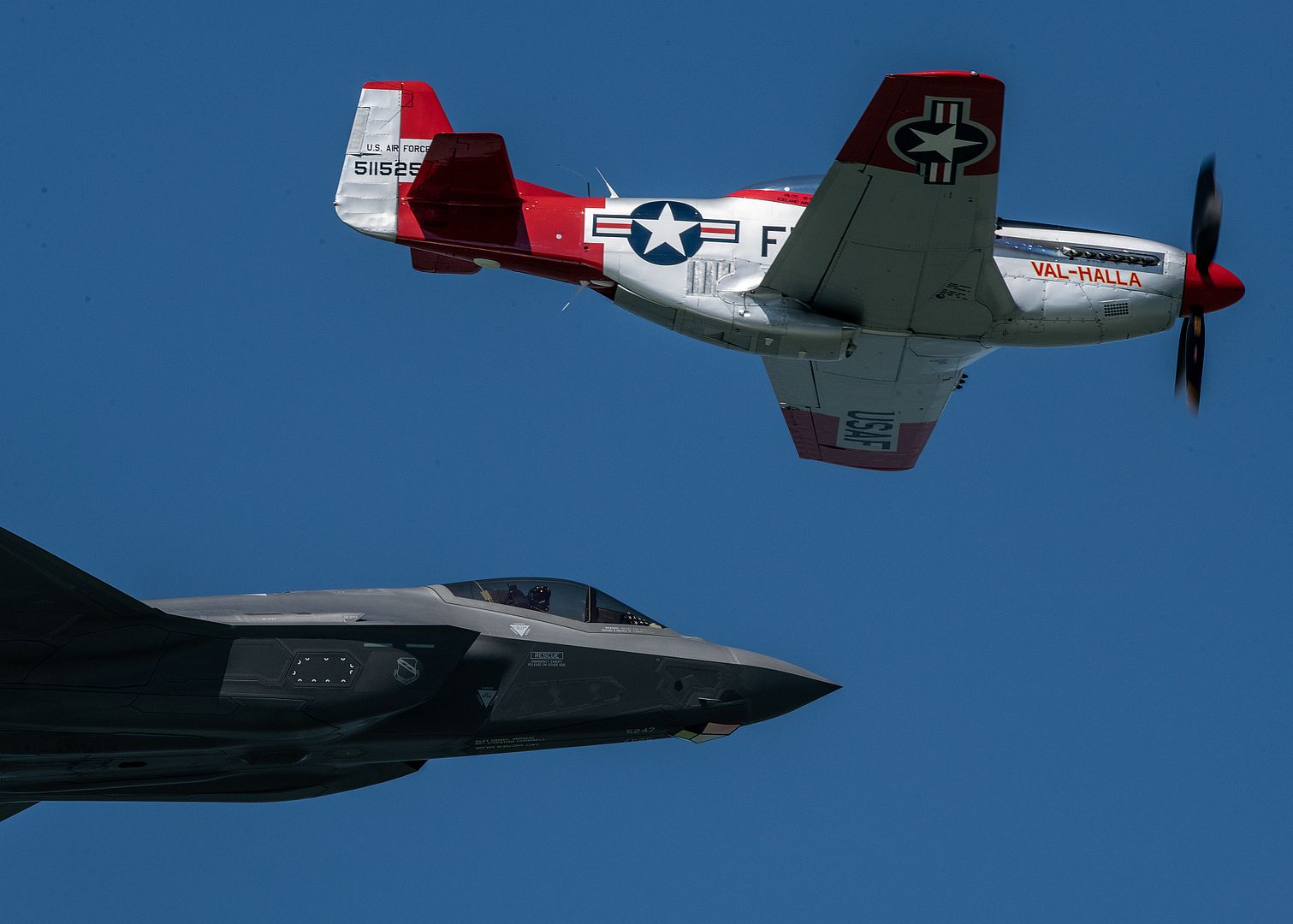
A U.S. KC-46A Pegasus, assigned to the 344th Air Refueling Squadron, taxis prior to takeoff in support of exercise Poseidon’s Rage, June 8, 2021. The integration with Air Mobility Command assets provides critical support to U.S. and NATO allies to ensure full mission success. (U.S. Air Force photo by Staff Sgt. Rachel Maxwell)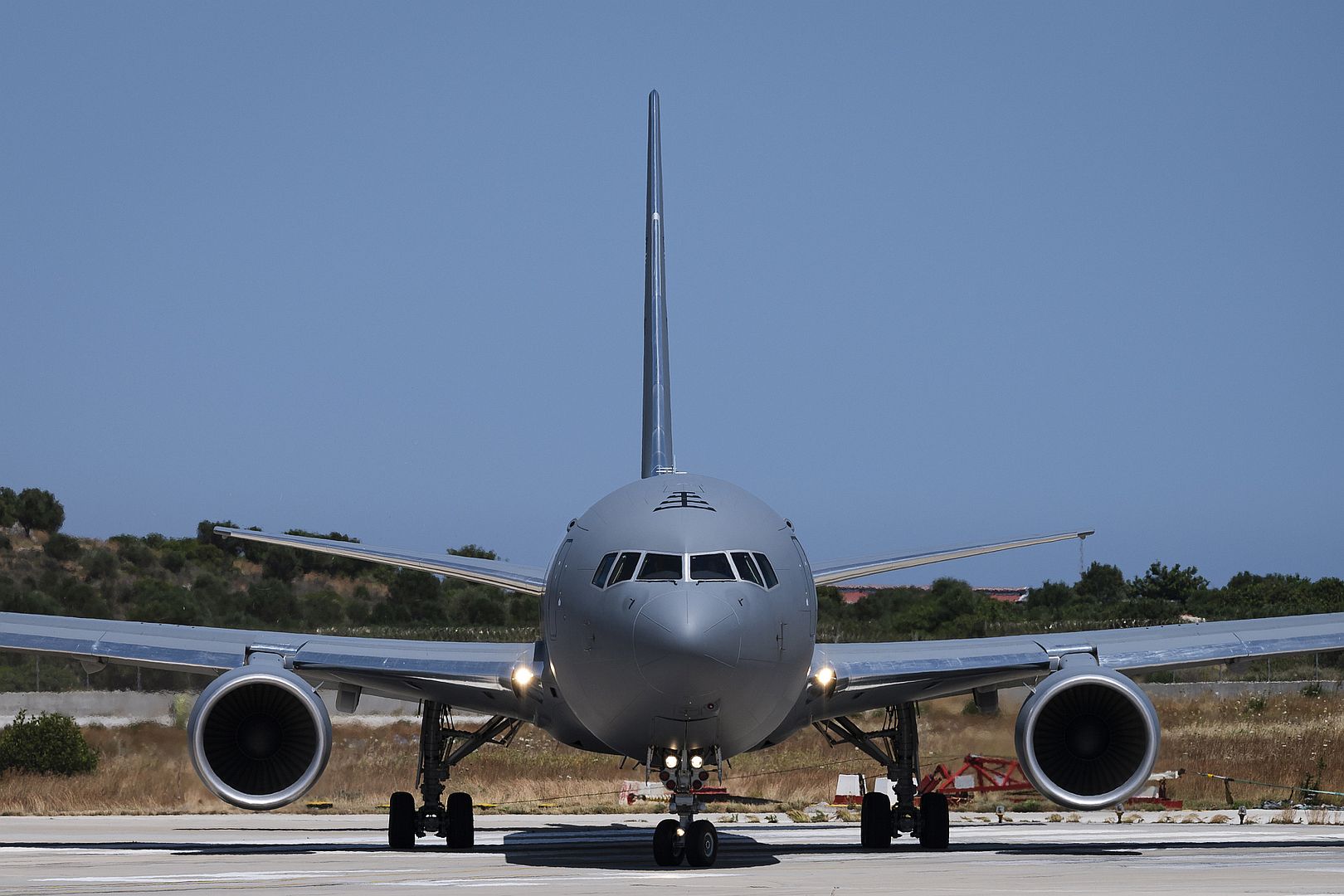
U.S. Air Force F-15E Strike Eagles assigned to the 48th Fighter Wing participate in exercise Poseidon’s Rage, over the Aegean Sea, June 7, 2021. The inaugural multinational exercise serves to develop and improve U.S.- Hellenic air readiness and interoperability. (U.S. Air Force photos by Staff Sgt. Rachel Maxwell).jpg?width=1920&height=1080&fit=bounds)
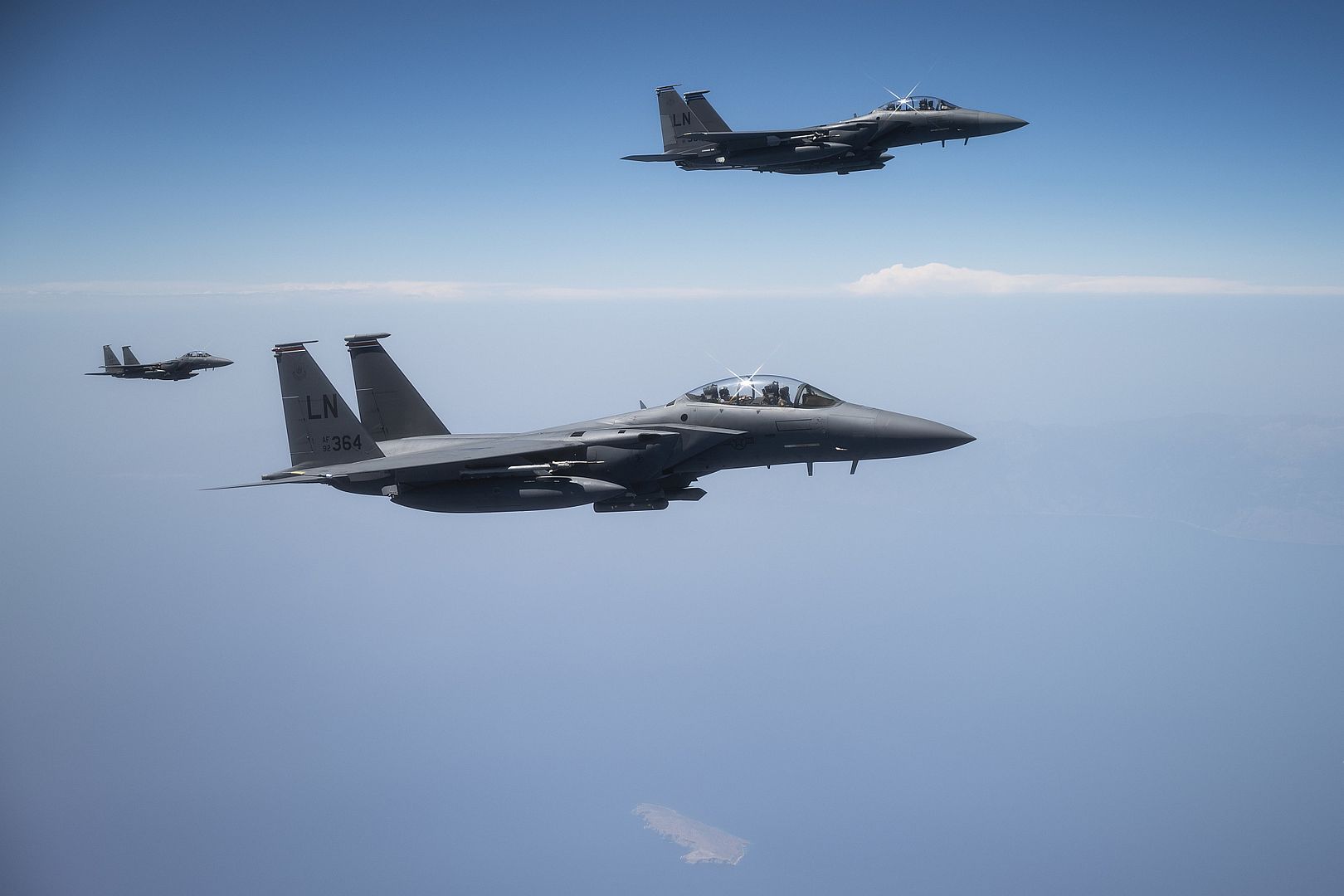

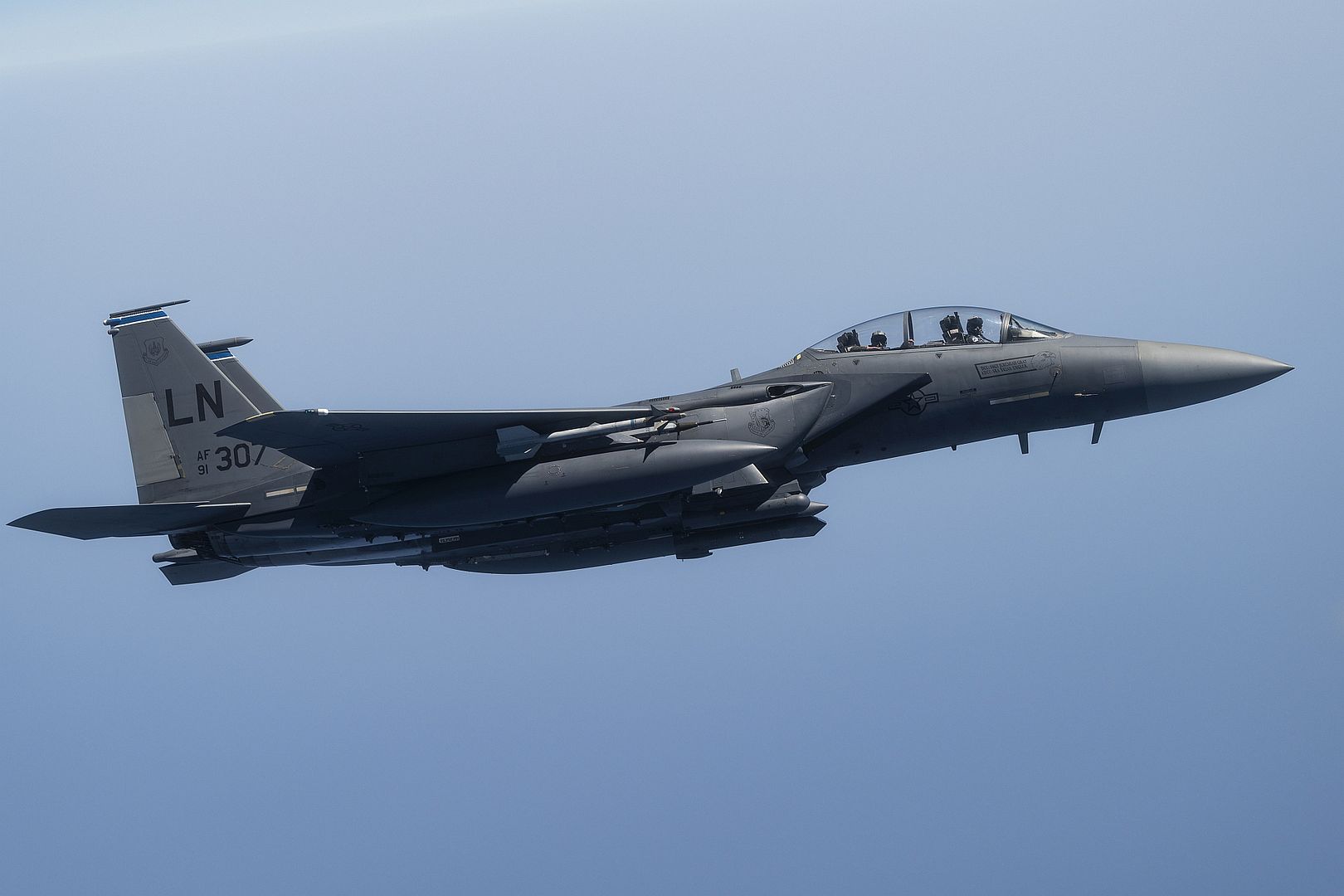
MEDITERRANEAN SEA (July 3, 2021) An F/A-18F Super Hornet, attached to the "Fighting Swordsmen" of Strike Fighter Squadron (VFA) 32, launches off the flight deck aboard the Nimitz-class aircraft carrier USS Dwight D. Eisenhower (CVN 69), in the Mediterranean Sea, July 3, 2021. The Dwight D. Eisenhower Carrier Strike Group is on a scheduled deployment in the U.S. 6th Fleet area of operations in support of U.S. national interests and security in Europe and Africa. (U.S. Navy photos by Mass Communication Specialist 3rd Class Brianna T. Thompson-Lee) .
.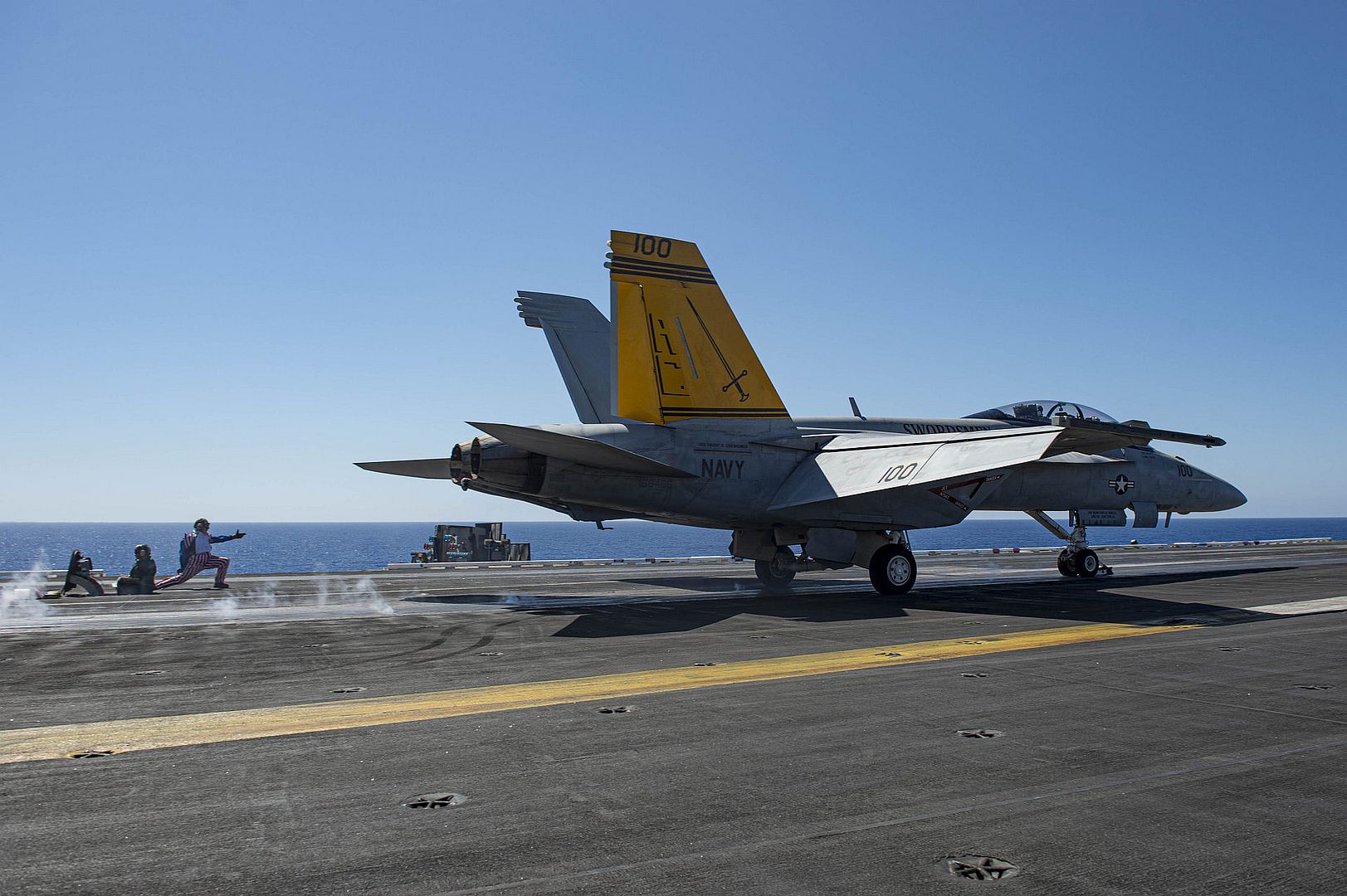
After the #Heifara mission to French Polynesia, the French deployed Rafales flew to Pearl Harbor Air Force base on the Hawaii archipelago.
The French pilots were able to strengthen bilateral cooperation with the United States in the Pacific, as part of a mission called WAKEA.
The Rafales have developed their interoperability with F-22 s on basic fighter maneuvers, basic combat maneuvers. These are tactical moves made by fighter aircraft during an air combat to gain a position advantage over the opponent.
A A400M has provided logistical support again. It also did some drop training. For the first time on a operational mission, this aircraft was in charge of providing rescue at sea when needed for a crew forced to eject. The A330 MRTT Phoenix, on the other hand, provided the Rafale s' in flight refueling during the exercises.
(Photos courtesy of the Armée de l'Air et de l'Espace )
-
 Main AdminA WC-130J Super Hercules aircraft assigned to the 53rd Weather Reconnaissance Squadron at Keesler Air Force Base, Miss., takes off for a flight into Tropical Storm Elsa July 6, 2021. The 53rd WRS “Hurricane Hunters” are an Air Force Reserve unit assigned to the 403rd Wing and are the only unit in the Department of Defense that flies weather reconnaissance missions .(U.S. Air Force photos by Staff Sgt. Kristen Pittman)
Main AdminA WC-130J Super Hercules aircraft assigned to the 53rd Weather Reconnaissance Squadron at Keesler Air Force Base, Miss., takes off for a flight into Tropical Storm Elsa July 6, 2021. The 53rd WRS “Hurricane Hunters” are an Air Force Reserve unit assigned to the 403rd Wing and are the only unit in the Department of Defense that flies weather reconnaissance missions .(U.S. Air Force photos by Staff Sgt. Kristen Pittman)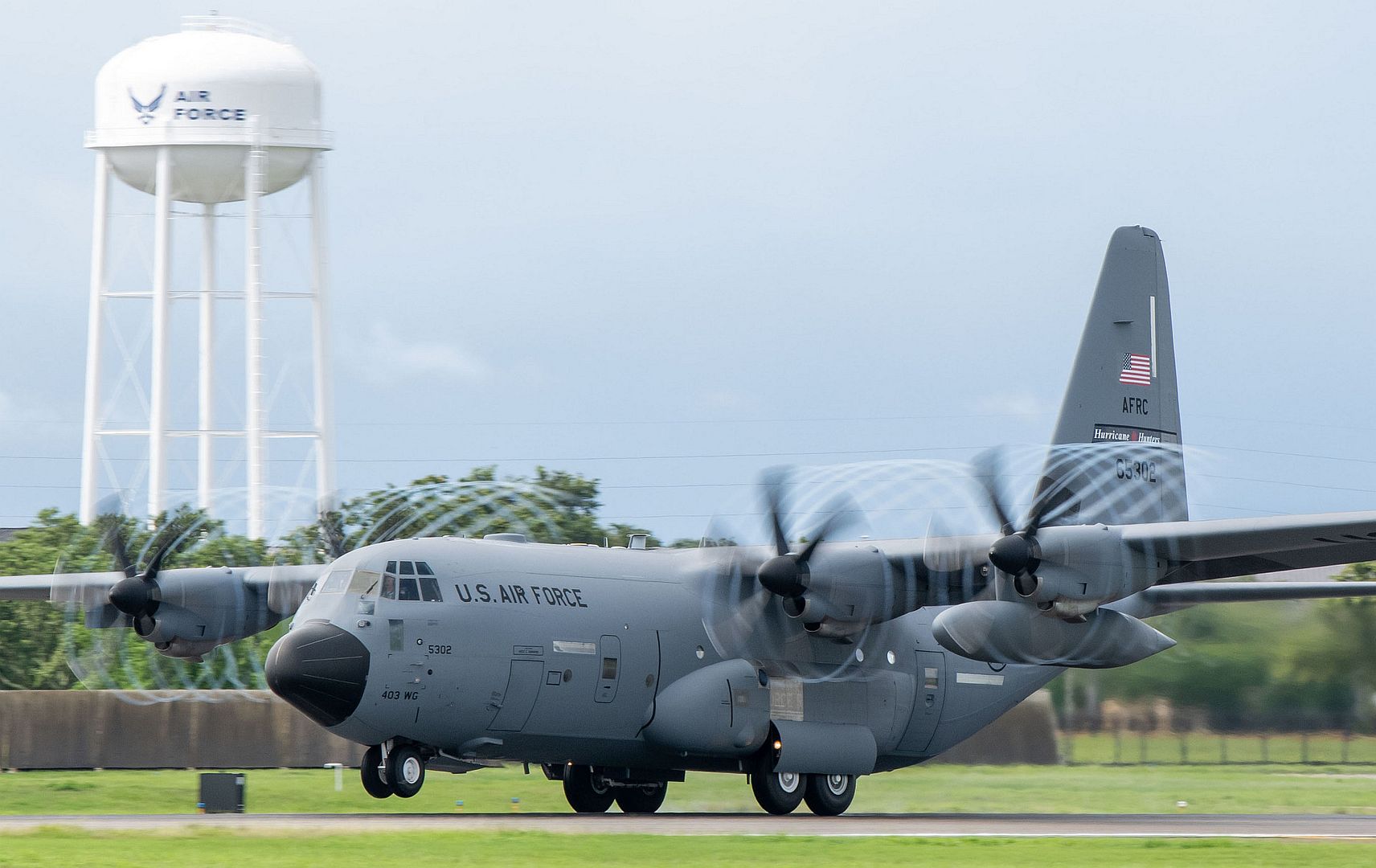

U.S. Navy P-8A Poseidons and air crews from Naval Air Station Jacksonville in Jacksonville, Fla., are marshaled in by 121st Air Refueling Wing Maintenance personnel at Rickenbacker Air National Guard Base, Ohio, July 6, 2021. The P-8s were moved to Rickenbacker ANGB in order to evacuate from the probable path of Hurricane Elsa. (U.S. Air National Guard photo by Staff Sgt. Wendy Kuhn)
French Air Force Rafales park on the flightline at Joint Base Langley-Eustis, July 6, 2021, while a 1st Fighter Wing F-22 Raptor takes off. (U.S. Air Force photo by Staff Sgt. River Bruce)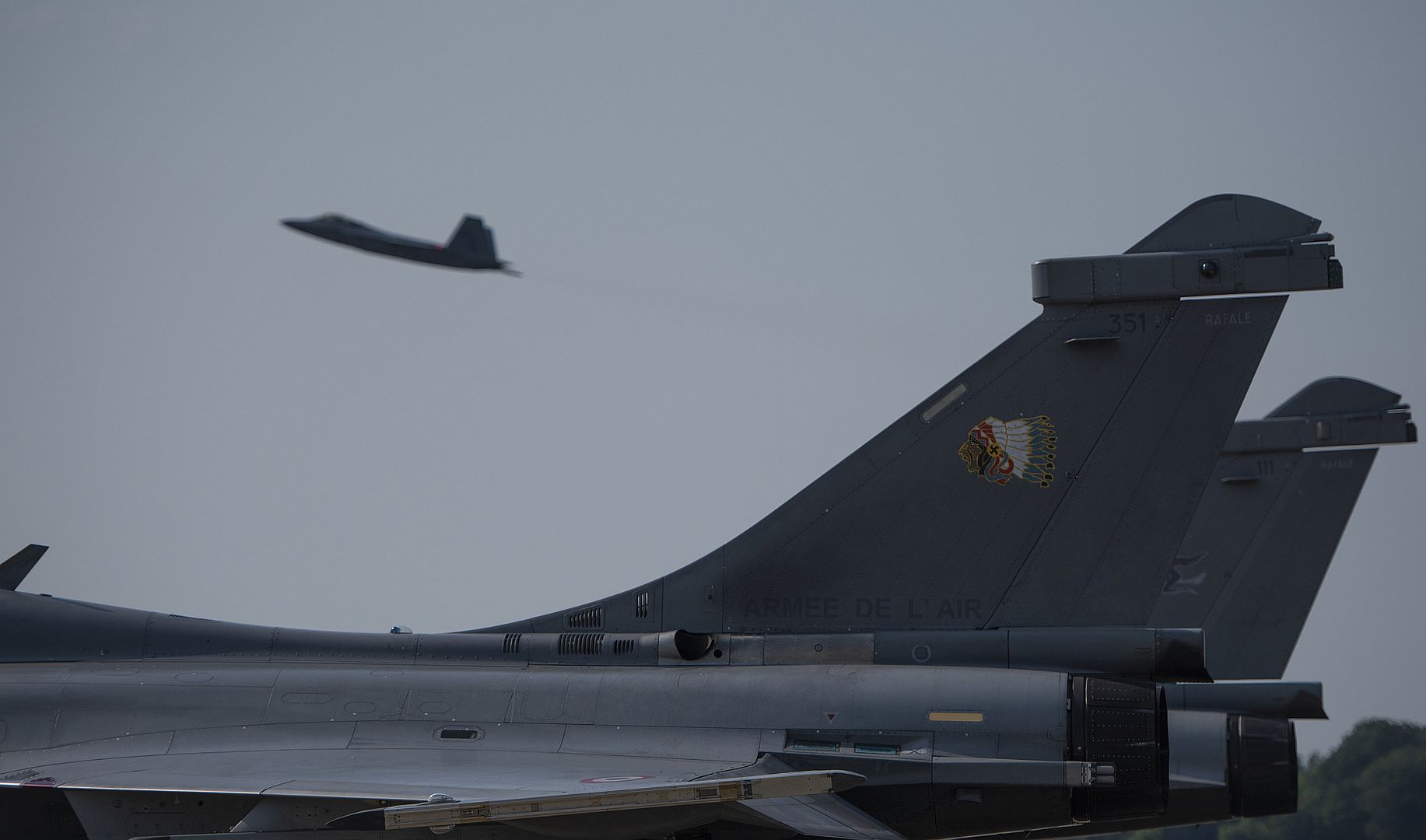
GULF OF ADEN (July 5, 2021) – An MV-22B Osprey tiltrotor aircraft, attached to Marine Medium Tiltrotor Squadron (VMM) 162 (Reinforced), takes off from the flight deck of amphibious assault ship USS Iwo Jima (LHD 7) during flight operations in the Gulf of Aden, July 5. Iwo Jima is deployed to the U.S. 5th Fleet area of operations in support of naval operations to ensure maritime stability and security in the Central Region, connecting the Mediterranean and Pacific through the western Indian Ocean and three strategic choke points. (U.S. Navy photo by Mass Communication Specialist 3rd Class Jessica Kibena)
PACIFIC OCEAN (July 5, 2021) An F/A-18F Super Hornet, assigned to the “Bounty Hunters” of Strike Fighter Squadron (VFA) 2, is prepped for launch from the flight deck of Nimitz-class aircraft carrier USS Carl Vinson (CVN 70), July 5, 2021. Vinson is currently underway conducting routine maritime operations in U.S. 3rd Fleet. (U.S. Navy photo by Mass Communication Specialist Seaman Isaiah Williams)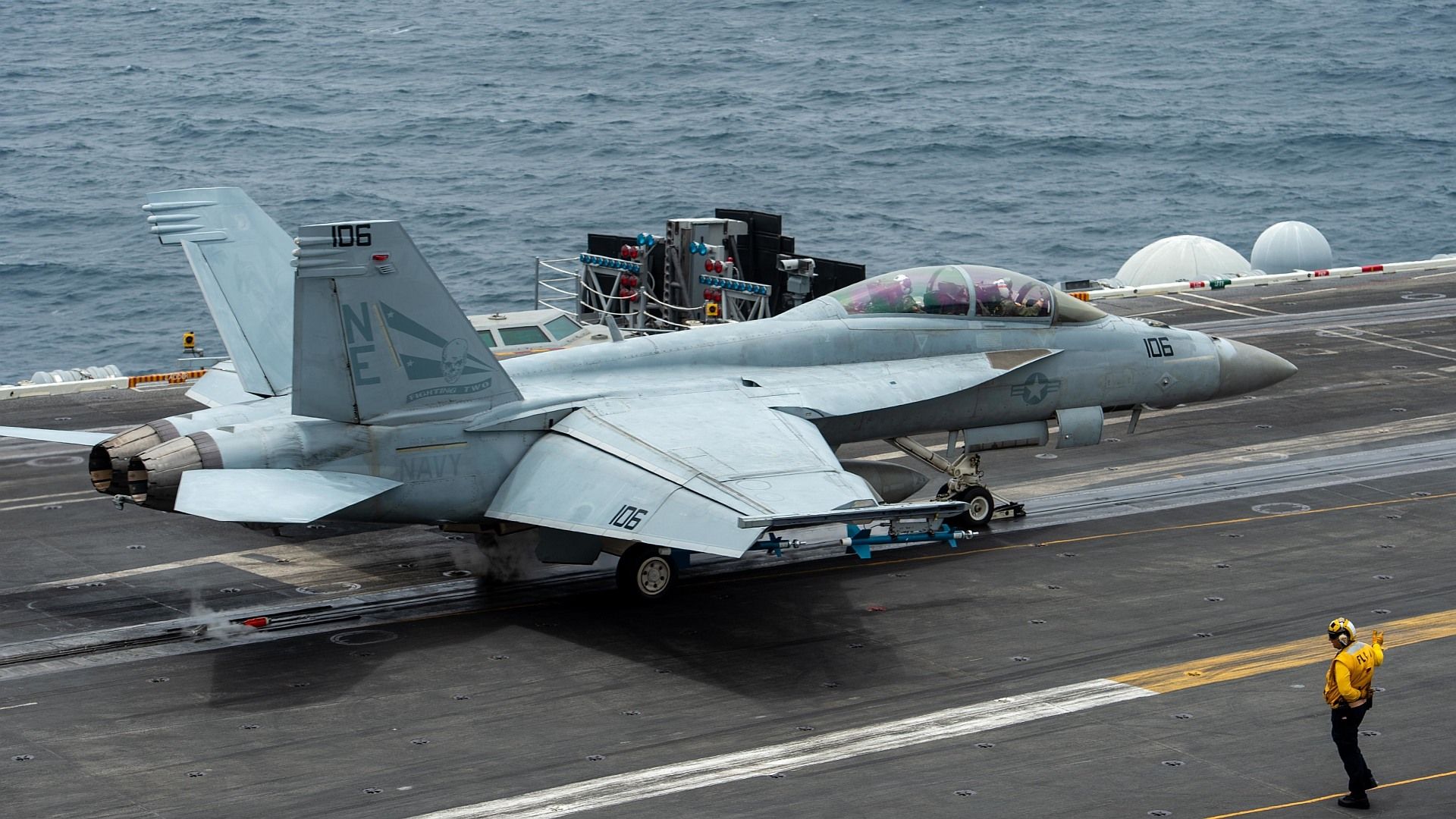
WASHINGTON (AFNS) --
The Air Force released a new B-21 Raider artist rendering graphic with an accompanying fact sheet today. As with past renderings, this rendering is an artist’s interpretation of the B-21 design.
The new rendering highlights the future stealth bomber with Edwards Air Force Base, California, as the backdrop. The 420th Flight Test Squadron based at Edwards AFB will plan, test, analyze and report on all flight and ground testing of the B-21 Raider.
The B-21 program continues to execute the Engineering and Manufacturing Development phase and is focused on scaling the manufacturing infrastructure and capacity across the industrial supply base to prepare for low rate initial production. A critical design review conducted in 2018 concluded the aircraft has a mature and stable design.
Designed to perform long range conventional and nuclear missions and to operate in tomorrow’s high end threat environment, the B-21 will be a visible and flexible component of the nuclear triad.
"Nuclear modernization is a top priority for the Department of Defense and the Air Force, and B-21 is key to that plan,” said Randall Walden, Air Force Rapid Capabilities Office director. “The built-in feature of open systems architecture on the B-21 makes the bomber effective as the threat environment evolves. This aircraft design approach sets the nation on the right path to ensuring America’s enduring airpower capability.”
The Air Force plans to incrementally replace the B-1 Lancer and the B-2 Spirit bombers to form a two-bomber fleet of B-21s and modified B-52s. The B-21 program is on track to deliver B-21s to the first operational base, Ellsworth AFB, South Dakota, in the mid-2020s.
(U.S. Air Force graphic)
July 06, 2021
Bombardier today announced the launch of the Bombardier Certified Pre-owned aircraft program, offering customers a premium class of pre-owned products. Each available aircraft is meticulously selected, inspected and updated to adhere to Bombardier's highest quality and safety standards. For buyers seeking a “like-new” experience, every Bombardier Certified Pre-owned aircraft is backed by an exclusive manufacturer one-year warranty*.
“As life gradually begins to return to normal, the supply of business jets across the industry has been outpaced by demand,” said Chris Milligan, Vice President, Pre-owned Aircraft Services, Bombardier. “A Bombardier Certified Pre-owned aircraft provides buyers with the highest quality pre-owned product, equipped with the latest safety and cabin enhancements – while providing the new aircraft delivery experience customers are looking for.”
Thanks to the Bombardier Certified Pre-owned aircraft program, customers can discover the high-quality array of available Bombardier business jets and sign up to receive alerts when an aircraft becomes available. As with all new Bombardier business jets, Bombardier Certified Pre-owned aircraft hold the promise of excellence in quality and reliability while demonstrating our commitment to maintaining the overall residual value of all Bombardier aircraft. Customers can count on Bombardier’s unparalleled expertise and know-how as the OEM to access, refurbish and provide services for the most exclusive selection of Bombardier pre-owned aircraft on the market.
“Bombardier’s Certified Pre-owned aircraft program is capitalizing on a resilient market where supply still hasn’t caught up with demand,” said Jean-Christophe Gallagher, Executive Vice President, Services and Support, and Corporate Strategy, Bombardier. “With so many new prospective buyers on the market, Bombardier can fulfill this demand and harness our world-renowned product knowledge, refurbishment capabilities and valuation know-how.”
For further customer peace of mind, each aircraft is equipped with the latest improvements in reliability through recommended maintenance inspections, service bulletins, systems upgrades and enrollment in Bombardier’s Smart Parts program, as required. Comfort is also at the forefront of this premium experience as the aircraft is delivered with a pristine cabin benefiting from the utmost care of services that range from a complimentary deep cleaning and sanitization to a fully refurbished interior.
A Bombardier Certified pre-owned aircraft combines operational efficiency with aesthetic beauty, while a fresh coat of Matterhorn white paint is the perfect canvas for customers to apply a personal touch with their signature livery. Upon delivery, customers have the guarantee that Bombardier as the OEM will stand by its products, providing support at the onset of operations and beyond.
Customers can count on an exclusive manufacturer warranty*, which extends to operational support during the first year, just like with new Bombardier aircraft. Those in search of the best quality in pre-owned aircraft can fly confidently knowing that Bombardier’s leading families of Learjet, Challenger and Global aircraft are backed by the strength and reach of Bombardier’s customer services offered across its worldwide and award-winning support network.
The launch of this new program closely follows the recent publication of the first Bombardier Pre-owned Market Report, an indispensable guide for all Bombardier pre-owned aircraft transactions.
RAF Voyager aircraft normally based at RAF Brize Norton in Oxfordshire are continuing to support Allied counter Daesh operations in the Middle East.
Recently a RAF Voyager was conducting a routine refuelling operation in the skies over Iraq when a French Air Force pilot flying a Rafale captured these images. They show the Voyager crew simultaneously refuelling both a RAF F-35B flying from HMS Queen Elizabeth and another Armée de l'Air et de l'Espace Rafale.
Commenting on the activities the RAF Air Component Commander, Air Commodore Simon Strasdin, said: "During the recent deployment of the F-35Bs from HMS Queen Elizabeth to support Operation SHADER, the aircraft were fully integrated into the Global Coalition and the counter Daesh operation."
-
 Main AdminU.S. Airmen assigned to the 354th Fighter Wing perform a hot pit refueling on an F-35A Lightning II aircraft assigned to the 355th Fighter Squadron on Eielson Air Force Base, Alaska, July 7, 2021. Hot pit refueling saves time, manpower and equipment usage by refueling an active aircraft in between flights. (U.S. Air Force photos by Airman 1st Class Jose Miguel T. Tamondong)
Main AdminU.S. Airmen assigned to the 354th Fighter Wing perform a hot pit refueling on an F-35A Lightning II aircraft assigned to the 355th Fighter Squadron on Eielson Air Force Base, Alaska, July 7, 2021. Hot pit refueling saves time, manpower and equipment usage by refueling an active aircraft in between flights. (U.S. Air Force photos by Airman 1st Class Jose Miguel T. Tamondong)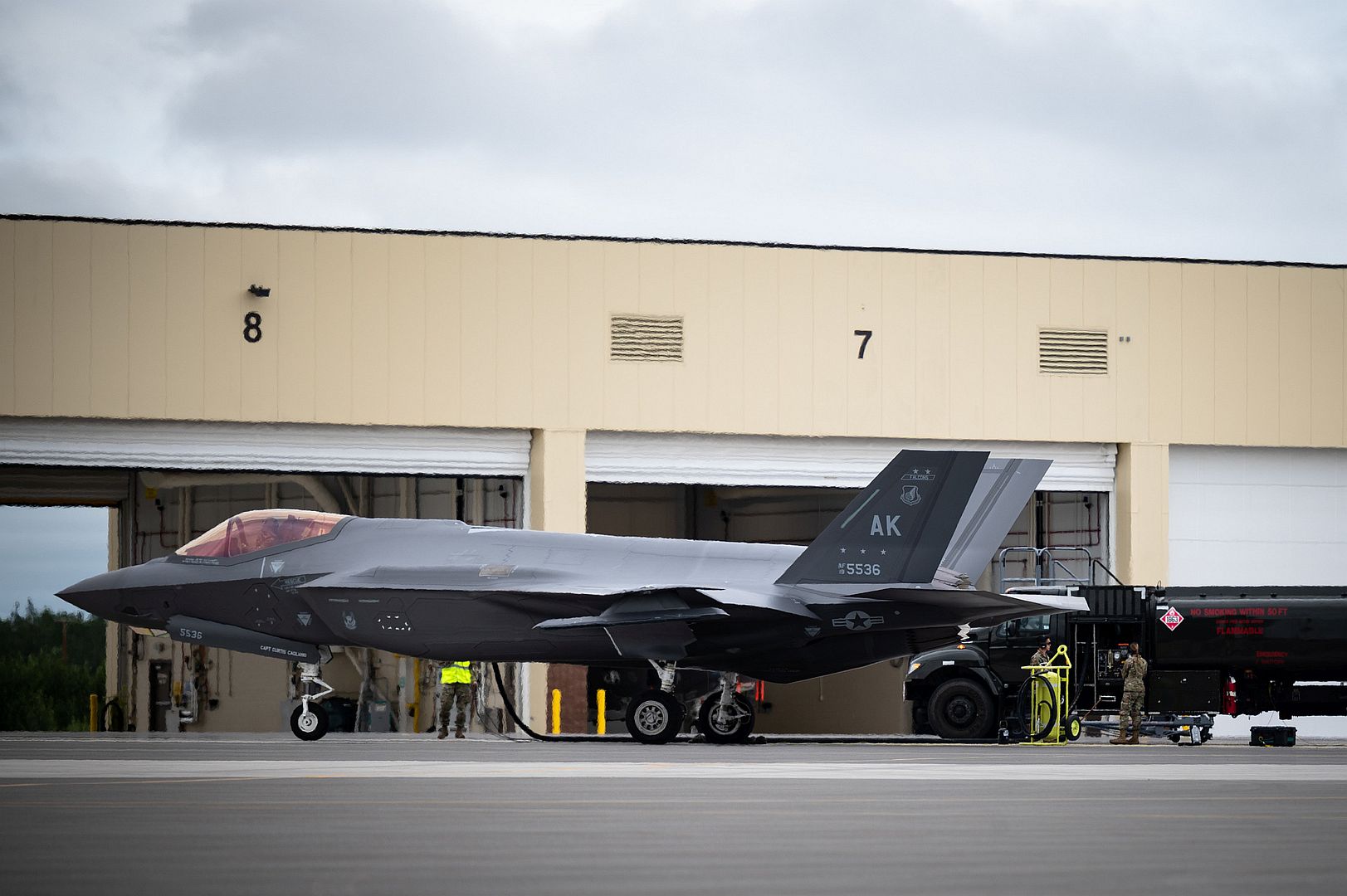
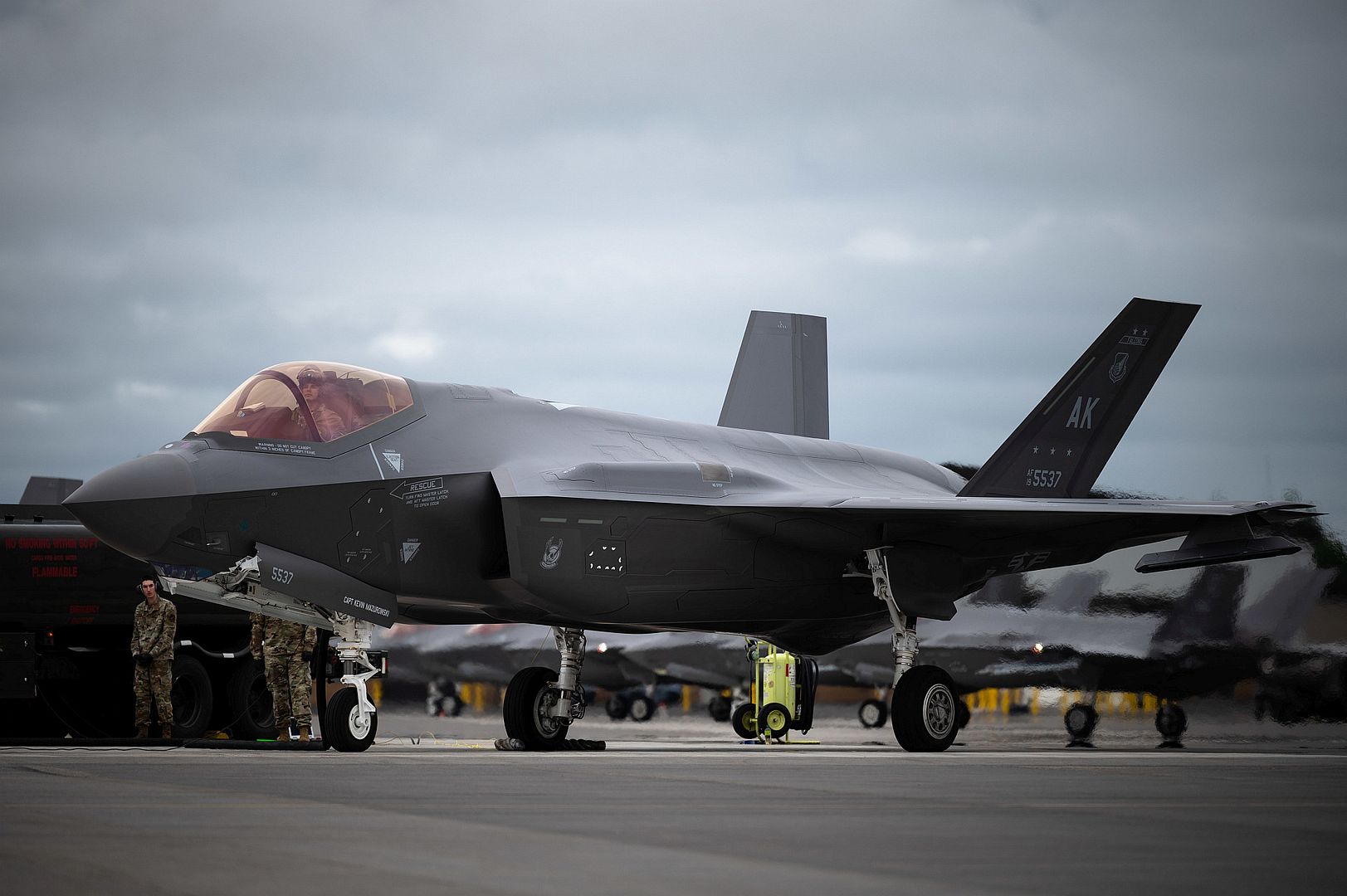
A U.S. Air Force A-10 Thunderbolt II from the 442nd Fighter Wing, U.S. Air Force Reserve, Whiteman Air Force Base, departs after receiving fuel in the skies near the border of Iowa and Missouri on July 7, 2020.
(U.S. Air National Guard photo: Senior Master Sgt. Vincent De Groot)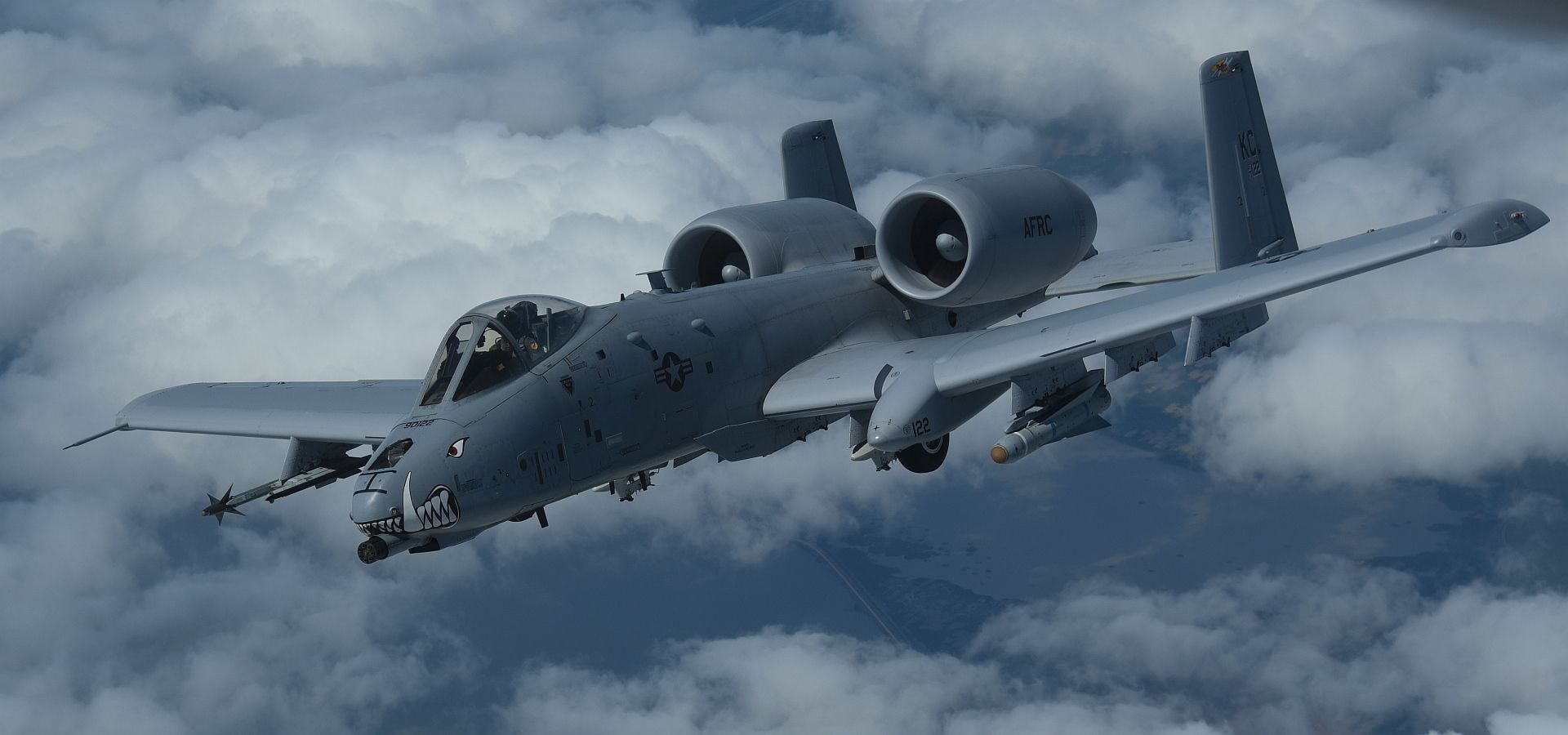
SELFRIDGE AIR NATIONAL GUARD BASE, MI, UNITED STATES 07.08.2021
A Navy P-3 Orion departs from Selfridge Air National Guard Base, Michigan with support personnel from Naval Air Station Jacksonville, Florida. The P-3 along with four P-8 Poseidon maritime patrol aircraft were at Selfridge to take shelter from Hurricane Elsa. The base's extensive ramp space make Selfridge a perfect location for hurricane evacuation support as well as a wide variety of transient aircraft. (U.S. Air National Guard photo by Terry L. Atwell)
PHILIPPINE SEA (July 6, 2021) Chief Aviation Boatswain's Mate (Handling) Akiel Mayers, from Ann Arbor, Mich., assigned to the forward-deployed amphibious assault ship USS America (LHA 6), signals the aircraft elevator operator on the ship's flight deck. America, flagship of the America Expeditionary Strike Group, along with the 31st Marine Expeditionary Unit, is operating in the U.S. 7th Fleet area of responsibility to enhance interoperability with allies and partners and serve as a ready response force to defend peace and stability in the Indo-Pacific region. (U.S. Navy photo by Mass Communication Specialist Seaman Matthew Cavenaile)
LOSSIEMOUTH, Scotland, July 8, 2021 — Boeing [NYSE: BA] and the UK Ministry of Defence have signed an agreement for Boeing to support the Royal Air Force’s (RAF) fleet of Poseidon MRA1 maritime patrol aircraft and train the crews that operate them.
“Our new Poseidon fleet continues to grow from strength to strength and is already defending the UK’s maritime interests at home and abroad,” said Defence Secretary Ben Wallace. “This contract with Boeing Defence UK secures our critical submarine-hunting aircraft capabilities whilst also creating a home-grown training enterprise and creating over 150 British jobs.”
Under the aircraft and training support contract, valued at $321.6 million (£233.5 million), Boeing will provide maintenance services, spares and repairs, including tools and ground support equipment, as well as supply chain management, forecasting and inventory management, and airworthiness services for the RAF’s P-8 fleet.
The training element of the contract will offer a suite of training systems and courseware to prepare aircrew and maintainers to safely and effectively operate and maintain the fleet. Boeing will provide the flight instructors to train P-8A pilots, and under the terms of a subcontract, Burgess Hill-based CAE UK will create more jobs in the UK to provide rear crew and engineering instructors, and console operators and controllers who will perform role playing and support functions during training and mission rehearsal exercises.
These agreements will create 150 jobs in the UK, including more than 100 at RAF Lossiemouth in northern Scotland. Boeing employees are already working alongside RAF personnel at the station in Moray, supporting the current fleet of five Poseidons.
“The P-8A Poseidon brings the RAF critical reconnaissance capabilities, and we are proud to be a trusted partner in helping to keep RAF aircrew trained, and the P-8A mission ready,” said Anna Keeling, managing director of Boeing Defence UK. “We are excited to see our continued growing presence in Scotland with the creation of these highly-skilled jobs, in addition to our existing footprint of more than 2,500 employees across the UK, reaffirming our commitment to help strengthen the aerospace and defense sector in Scotland.”
The RAF is on contract for nine Poseidon aircraft with five already delivered and the remaining four scheduled for later this year, when around 200 Boeing employees are expected to be based at RAF Lossiemouth focused on maintenance, training and support.
The second of two Operational Flight Trainers, jointly developed by Boeing and CAE for the Poseidon fleet, arrived at RAF Lossiemouth last month. Both will be installed in the Boeing-built Strategic Facility, which accommodates three Poseidon aircraft, squadrons and mission support facilities.
The P-8A Poseidon supports maritime surveillance, anti-submarine warfare and anti-ship warfare for the UK, and increases protection of the UK’s nuclear deterrent and Queen Elizabeth class aircraft carriers. More than a dozen UK-based suppliers produce components for the P-8, making up five percent of every P-8 aircraft around the world. Marshall Aerospace and Defence Group has built and delivered more than 900 auxiliary fuel tanks from its production facility in Cambridge.
(Photo courtesy of the RAF)
SAN DIEGO – 08 July 2021 – General Atomics Aeronautical Systems, Inc. (GA-ASI) announced yesterday the completion of the first MQ-9A Block 5 Remotely Piloted Aircraft (RPA) and Ground Control Station (GCS) for the Royal Netherlands Air Force (RNLAF). GA-ASI and RNLAF commemorated the occasion with a special roll-out ceremony at GA-ASI’s corporate headquarters in Poway, Calif., and the event was simulcast to the Netherlands.
The aircraft will begin its acceptance testing later this year at GA-ASI’s Gray Butte Flight Operations Facility near Palmdale, Calif., and the aircraft will be delivered to the Netherlands before the end of 2021. The total Foreign Military Sales agreement includes four MQ-9A Block 5 aircraft and four mobile Ground Control Stations, along with associated support equipment.
“We are proud to begin this new relationship with the Royal Netherlands Air Force,” said Linden Blue, GA-ASI CEO. “With millions of hours of proven performance under its wings, the MQ-9 is ideally suited to support their nation’s ISR needs. The Netherlands now joins the United Kingdom, Italy, France and Spain as NATO countries operating our advanced RPAs, with Belgium coming online in the next few years.”
With unmatched operational flexibility, MQ-9A Block 5 has endurance of over 27 hours, speeds of 240 KTAS and can operate up to 50,000 feet. It has a 3,850 pound (1,746 kilogram) payload capacity that includes 3,000 pounds (1,361 kilograms) of external stores. It provides a long-endurance, persistent surveillance capability with Full-Motion Video and Synthetic Aperture Radar/Moving Target Indicator/Maritime Radar. An extremely reliable aircraft, MQ-9A Block 5 is equipped with a fault-tolerant flight control system and triple redundant avionics system architecture. It is engineered to meet and exceed manned aircraft reliability standards.
About GA-ASI
General Atomics Aeronautical Systems, Inc. (GA-ASI), an affiliate of General Atomics, is a leading designer and manufacturer of proven, reliable Remotely Piloted Aircraft (RPA) systems, radars, and electro-optic and related mission systems, including the Predator® RPA series and the Lynx® Multi-mode Radar. With close to seven million flight hours, GA-ASI provides long-endurance, mission-capable aircraft with integrated sensor and data link systems required to deliver persistent flight that enables situational awareness and rapid strike. The company also produces a variety of ground control stations and sensor control/image analysis software, offers pilot training and support services, and develops meta-material antennas. For more information, visit www.ga-asi.com.
-
 Main AdminA U.S. Navy P-8A Poseidon maritime patrol and reconnaissance aircraft assigned to Patrol Squadron FOUR (VP-4) “Skinny Dragons” is photographed at Camp Lemonnier, Djibouti, July 8, 2021. The P-8A Poseidon Multi-mission Maritime Aircraft (MMA) design is based on the Boeing 737-800 aircraft with significant modifications to support Navy maritime patrol mission requirements. (U.S. Air Force photos by Staff Sgt. Missy Sterling)
Main AdminA U.S. Navy P-8A Poseidon maritime patrol and reconnaissance aircraft assigned to Patrol Squadron FOUR (VP-4) “Skinny Dragons” is photographed at Camp Lemonnier, Djibouti, July 8, 2021. The P-8A Poseidon Multi-mission Maritime Aircraft (MMA) design is based on the Boeing 737-800 aircraft with significant modifications to support Navy maritime patrol mission requirements. (U.S. Air Force photos by Staff Sgt. Missy Sterling)

An F-35B with Marine Fighter Attack Squadron 122, Marine Air Group 13, 3rd Marine Aircraft Wing (MAW), conducts an air to air refueling operation with a KC-130J Hercules, during Marine Corps training exercise Summer Fury in California, July 8, 2021. Aerial refueling facilitates 3rd MAW aircrafts to conduct precision-guided munitions and long-range strikes to contend with a number of new and different threats in the 21st century. Summer Fury is an exercise conducted by 3rd MAW in order to maintain and build capability, strength and trust within its units to generate the readiness and lethality needed to deter and defeat adversaries during combat operations as the U.S. Marine Corps refines tactics and equipment during Force Design 2030. (U.S. Marine Corps photo by Lance Cpl. Quince Bisard)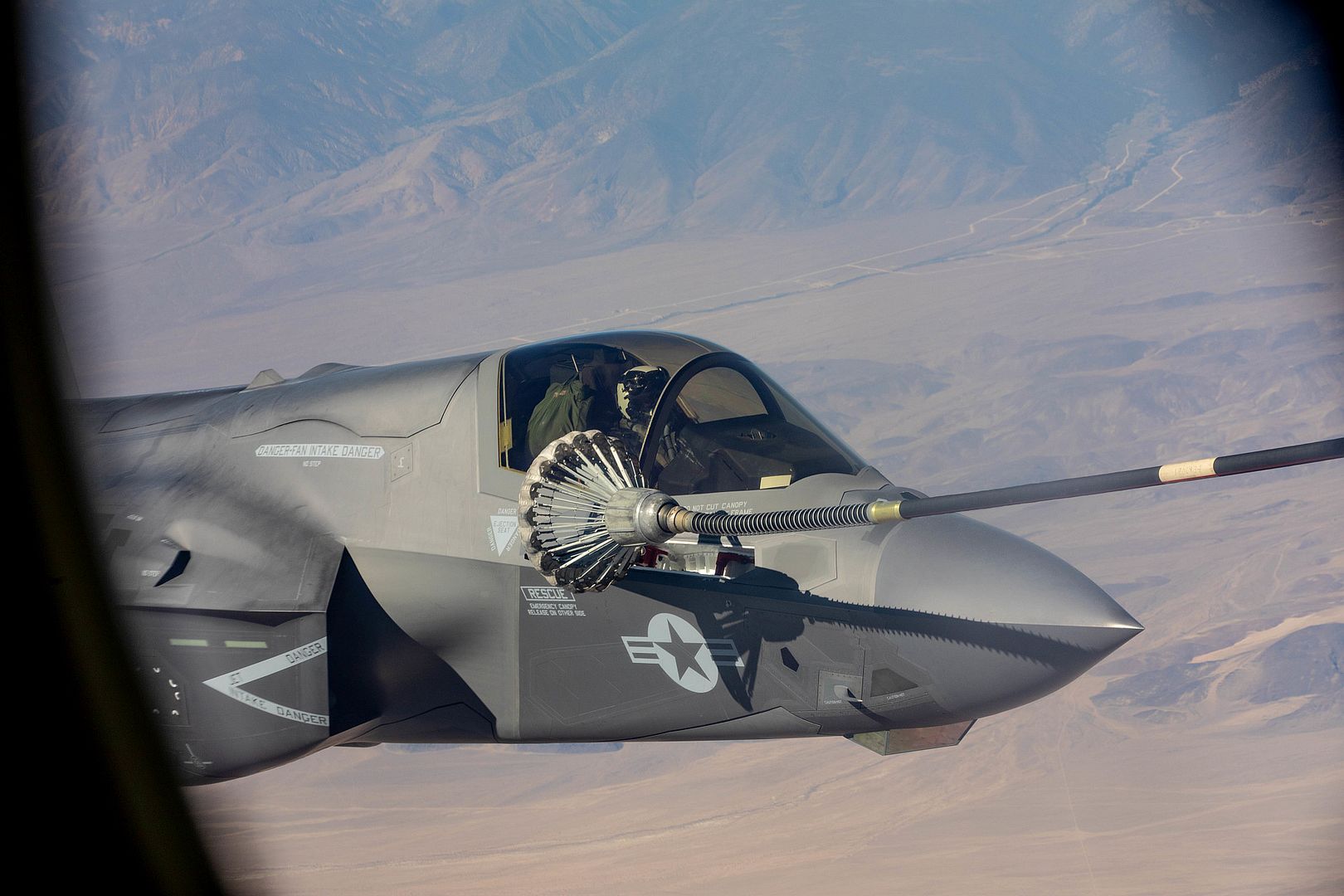
The flagship aircraft with Marine Medium Tiltrotor Squadron (VMM) 161, Marine Aircraft Group 16, 3rd Marine Aircraft Wing, conducts an air to air refueling operation with a KC-130J Hercules, during Marine Corps training exercise Summer Fury at Marine Corps Air Station Miramar, California, July 7, 2021. The importance of aerial refueling is to extend the range or time of an aircraft’s ability to remain in the air and combat effective during maritime operations, especially in coastal regions, which will be contested and dangerous, compelling the Marine Corps to operate in an increasingly dispersed manner. Summer Fury is an exercise conducted by 3rd MAW in order to maintain and build capability, strength and trust within its units to generate the readiness and lethality needed to deter and defeat adversaries during combat operations as the U.S. Marine Corps refines tactics and equipment during Force Design 2030. (U.S. Marine Corps photo by Lance Cpl. Quince Bisard)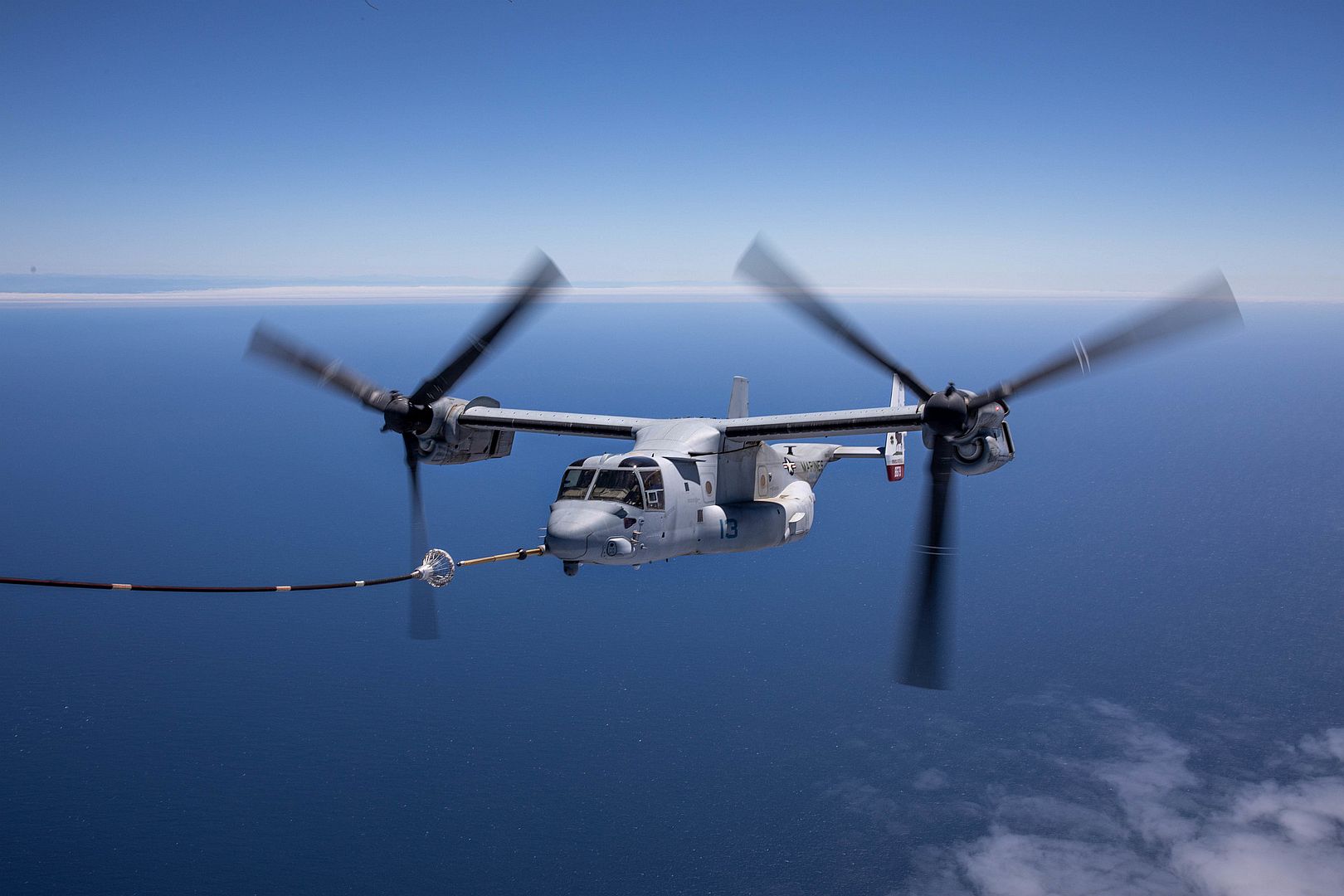
U.S Air Force F-15C Eagles assigned to the 493rd Fighter Squadron take off from the flighline in support of NATO Air Policing operations at Royal Air Force Lakenheath, England, on July 7, 2021. Operations and exercises like the NATO Air Police mission uphold international rule-based order and maintain a steadfast layer of collective defense for all allied Arctic members. (U.S. Air Force photos by Senior Airman Koby I. Saunders)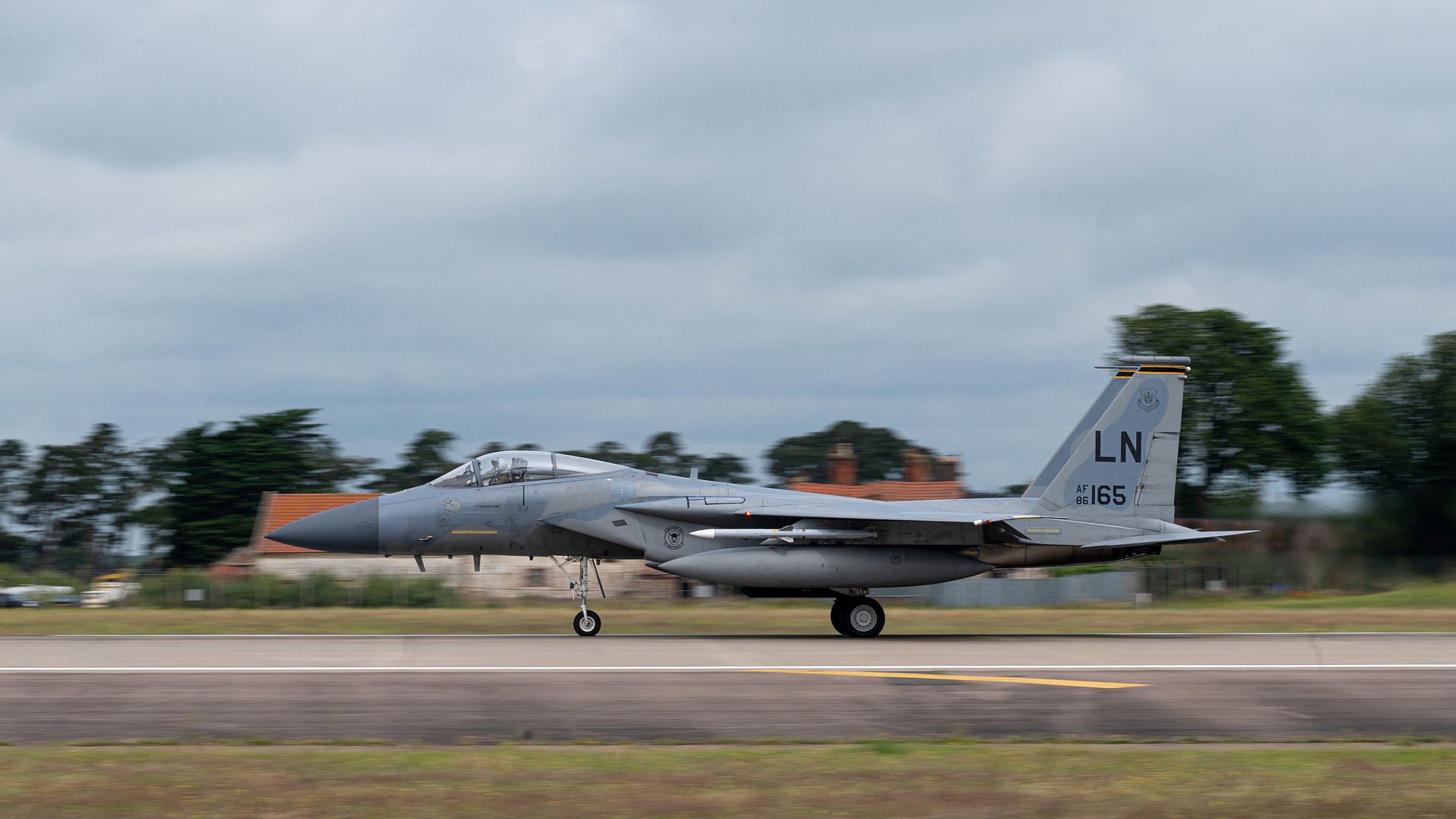
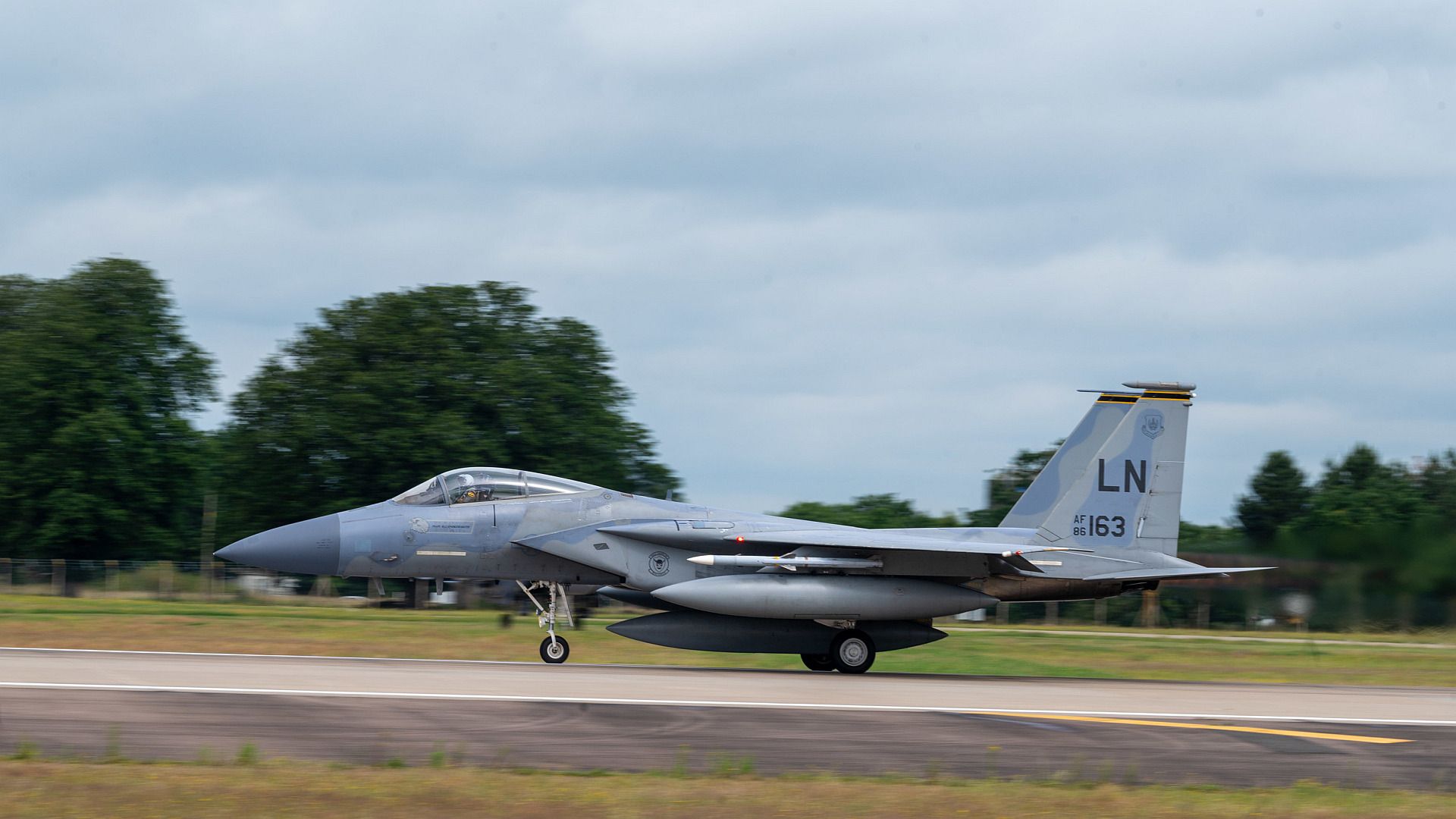
A U.S. Air Force F-16 Fighting Falcon assigned to the 555th Fighter Squadron, taxis off the flightline at Graf Ignatievo Air Base, Bulgaria, July 9, 2021. Eight F-16s from the 555th FS are participating in Thracian Star 21, a multilateral training opportunity to test the squadron’s ability to rapidly forward deploy, sustain operations, and work in coordination with our partners and allies. (U.S. Air Force photo by Airman 1st Class Brooke Moeder)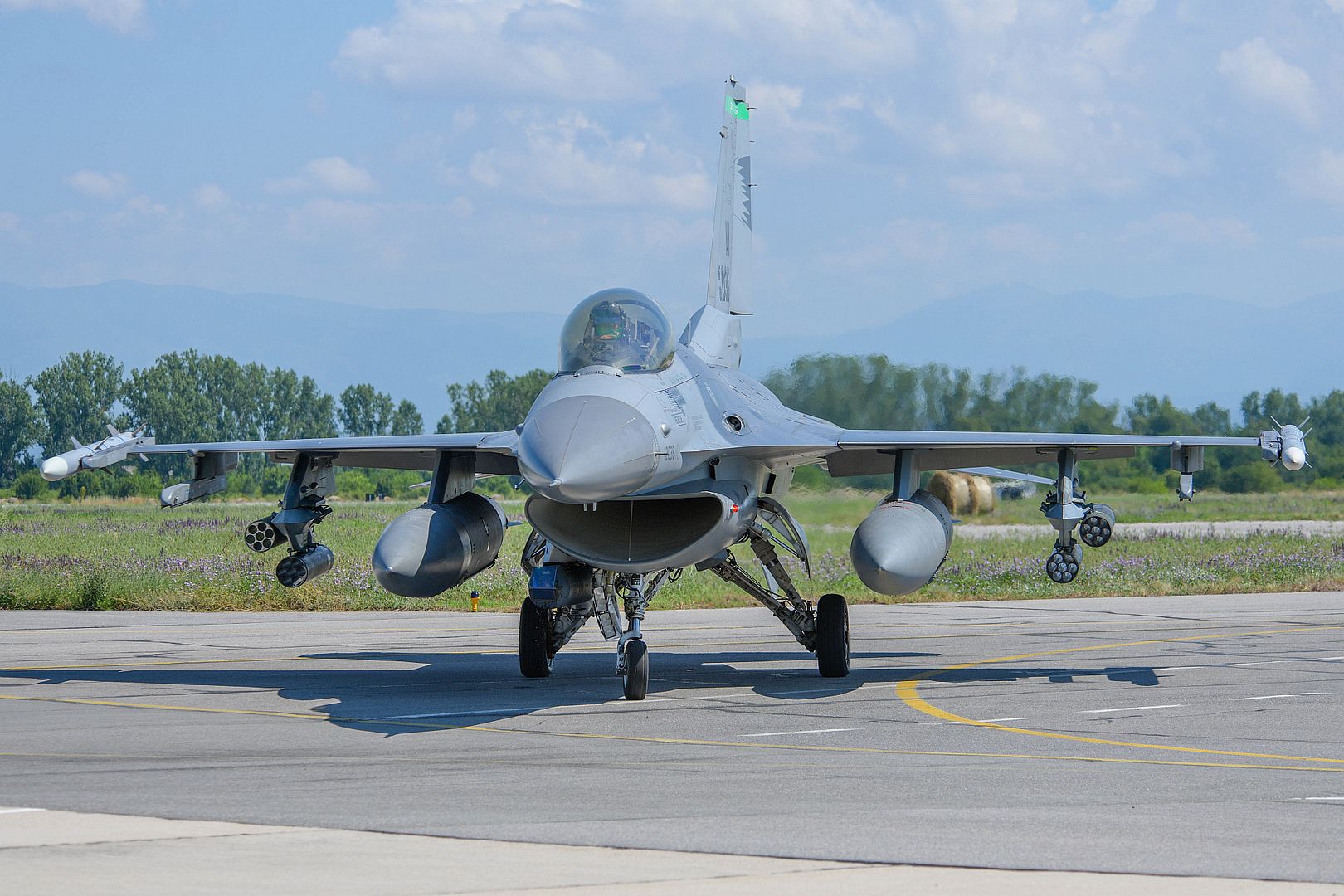
PACIFIC OCEAN (July 8, 2021) An EA-18G Growler, assigned to the “Gauntlets” of Electronic Attack Squadron (VAQ) 136, lands on the flight deck of Nimitz-class aircraft carrier USS Carl Vinson (CVN 70), July 8, 2021. Vinson is currently underway conducting routine maritime operations in U.S. 3rd Fleet. (U.S. Navy photo by Mass Communication Specialist Seaman Apprentice Sophia Simons)
RENTON, Wash., July 9, 2021 – The first P-8A Poseidon aircraft for Norway today rolled out of the paint shop in Renton, in Royal Norwegian Air Force livery. Norway is one of eight nations to have acquired the P-8A as their new multimission maritime patrol aircraft.
Recently, the air force revealed the names of its five P-8A Poseidon aircraft: Vingtor, Viking, Ulabrand, Hugin and Munin. The names are inspired by Norse mythology and continue a tradition of almost 80 years that started when the names Vingtor, Viking and Ulabrand were used on Norway’s PBY-5 Catalina maritime patrol aircraft in 1942. Since then, other maritime patrol aircraft operated by the Royal Norwegian Air Force have carried those names, including its current P-3 fleet, which will be replaced by the P-8.
Norway's first P-8A aircraft – Vingtor – will now return to the factory floor to be prepared for flight testing. First flight is scheduled for later this month, and mission systems will be installed on the aircraft after that.
Moscow, 08 July 2021 – Airbus will demonstrate its latest technological innovations and projects implemented in Russia at the International Aerospace Show which takes place in Zhukovsky from 20th to 25th July. Key attractions will be the last-generation widebody A350-1000, which will be shown in the country for the first time, and the twin-engine EC145 rotorcraft.
The A350-1000 is the largest member of the clean sheet design A350 widebody Family, with a seating capacity of up to 440 passengers in a single class. The aircraft's state-of-the-art aerodynamics, inspired by nature, incorporates a unique morphing technology that continuously optimises the wing profile to reduce drag and lower fuel burn and CO2 emissions. The aircraft is powered by Rolls Royce Trent XWB 97 engines with 15% increased thrust, the aircraft can fly up to 16,100km. More than 70% of the airframe is made from advanced materials, including 53% composites. Aeroflot already operates 6 A350-900.
The Airbus A350-1000 will also take part in the flight programme of MAKS-2021 aerospace show from 20 to 22 of July.
Another highlight on static display will be the EC145 helicopter – one of the 5 EC145, owned by the city of Moscow and operated by the Moscow Aviation Centre (MAC). Airbus Helicopters and the Moscow Aviation Centre have been cooperating for more than 14 years. During this period, the MAC AH fleet has contributed to saving the lives of more than 6,400 patients in the territory of Moscow. Easy access to the cockpit through wide, side-sliding doors or through the rear doors, a spacious cabin, and high reliability make this helicopter the preferred choice for medical missions.
The Airbus Defence and Space division is known for its long-term cooperation with Russian enterprises. Together with Russian colleagues, they implemented several international projects under the Automated Transfer Vehicle (ATV) and International Space Station programmes, as well as cooperation with the Russian OKB “Fakel” in terms of building the satellites for the OneWeb constellation. The Space division of Airbus is the only Western space division that has a proven track record in industrial localisation of production in the Russian Federation. Airbus Defence and Space will demonstrate samples of localised production and future power amplifiers proposed for further development. Another promising area, both international and Russian, is the global information system and services based on data from Earth Remote Sensing (ERS) satellites.
The Defence and Space division will also demonstrate space equipment produced by the joint venture Airbus DS and JSC Russian Space Systems, and the Airbus engineering centre in Moscow, ECAR, will demonstrate the results of its work and current projects (to be confirmed later)
-
 Main AdminU.S. Air Force F-15C Eagles assigned to the 493rd Fighter Squadron, taxi prior to a training sortie in support of NATO Air Policing operations at Keflavik Air Base, Iceland, July 9, 2021. NATO Air Policing is a peacetime collective defensive mission that safeguards the integrity of NATO alliance members’ airspace. (U.S. Air Force photo by Staff Sgt. Rachel Maxwell)
Main AdminU.S. Air Force F-15C Eagles assigned to the 493rd Fighter Squadron, taxi prior to a training sortie in support of NATO Air Policing operations at Keflavik Air Base, Iceland, July 9, 2021. NATO Air Policing is a peacetime collective defensive mission that safeguards the integrity of NATO alliance members’ airspace. (U.S. Air Force photo by Staff Sgt. Rachel Maxwell)
U.S. Air Force F-15C Eagles assigned to the 493rd Fighter Squadron, taxi after completing a training sortie in support of NATO Air Policing operations at Keflavik Air Base, Iceland, July 9, 2021. Air defence flying training missions provide the necessary degree of training to NATO and Icelandic support personnel to ensure that the Alliance can conduct a full-scale peacetime air-policing mission at the shortest possible notice if required by real world events. (U.S. Air Force photo by Staff Sgt. Rachel Maxwell)
PACIFIC OCEAN (July 9, 2021) Sailors conduct pre-flight checks on an F/A-18E Super Hornet, assigned to the “Stingers” of Strike Fighter Squadron (VFA) 113, on the flight deck of Nimitz-class aircraft carrier USS Carl Vinson (CVN 70), July 9, 2021. Vinson is currently underway conducting routine maritime operations in U.S. 3rd Fleet. (U.S. Navy photo by Mass Communication Specialist Seaman Sophia Simons)
PHILIPPINE SEA (July 9, 2021) An F-35B Lightning II fighter aircraft from the 31st Marine Expeditionary Unit (MEU) is parked on the flight deck of the forward-deployed amphibious assault ship USS America (LHA 6). America, flagship of the America Expeditionary Strike Group, along with the 31st Marine Expeditionary Unit, is operating in the U.S. 7th Fleet area of responsibility to enhance interoperability with allies and partners and serve as a ready response force to defend peace and stability in the Indo-Pacific region. (U.S. Navy photo by Mass Communication Specialist 3rd Class Theodore C. Lee)_is_parked_on_the_flight_deck_of_the_forward-deployed_amphibious_assault_ship_USS_America.jpg?width=1920&height=1080&fit=bounds)
ARABIAN GULF (July 11, 2021) – A United Arab Emirates Royal Air Force Apache helicopter takes off from the flight deck of expeditionary sea base USS Lewis B. Puller (ESB 3), not pictured, during flight operations in the Arabian Gulf, July 11. Lewis B. Puller is deployed to the U.S. 5th Fleet area of operations in support of naval operations to ensure maritime stability and security in the Central Region, connecting the Mediterranean and Pacific through the western Indian Ocean and three strategic choke points. (U.S. Navy photo by Mass Communication Specialist 3rd Class Dawson Roth)
GULF OF ADEN (July 12, 2021) Ships of the UK Carrier Strike Group, USS Ronald Reagan Carrier Strike Group, and Iwo Jima Amphibious Ready Group operate in formation in the Gulf of Aden, July 12. UK, Dutch and U.S. naval forces conducted an integrated at-sea exercise designed to enhance maritime interoperability and demonstrate naval integration through a series of training scenarios. (U.S. Navy photos by Mass Communication Specialist Seaman Gray Gibson)


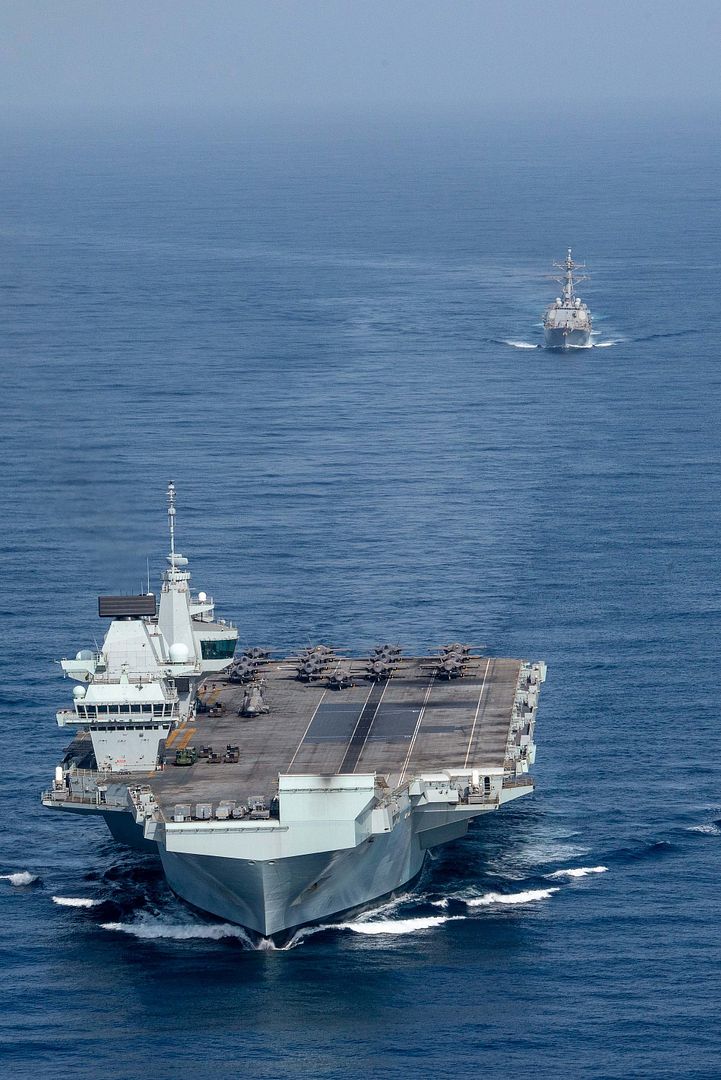
A black and grey U.S. Air Force A-10 Thunderbolt II from the Indiana Air National Guard’s 122nd Fighter Wing “Blacksnakes,” painted at the Air National Guard paint facility in Sioux City, Iowa on July 2, 2021. In a departure from the standard A-10 two-tone grey, the paint scheme was created by request in order to commemorate the 100th anniversary of aviation in the Indiana National Guard.
U.S. Air National Guard photos: Senior Master Sgt. Vincent De Groot










SEATTLE, July 12, 2021 — Boeing [NYSE: BA] and BBAM Limited Partnership (BBAM) today announced that the lessor is expanding its 737-800 Boeing Converted Freighter fleet with 12 additional firm orders. The agreement brings BBAM’s 737-800BCF orders and commitments to 31 as e-commerce and express cargo markets continue to drive strong customer demand for freighters.
BBAM will be the first customer to have a 737-800BCF converted at Cooperativa Autogestionaria de Servicios Aeroindustriales (COOPESA), a Costa Rica-based maintenance, repair and overhaul (MRO) provider. In May, Boeing announced it would open two conversion lines at COOPESA in 2022.
“The Boeing Converted Freighter program is extending the life and enhancing the value of the 737-800s in our fleet,” said Steve Zissis, president and CEO of BBAM. “We are growing our Boeing order book to meet the strong demand we see worldwide for narrowbody freighters, and we are proud to be the launch customer for the conversion lines at COOPESA.”
In a separate deal announced in January, BBAM placed six firm orders and six options for the 737-800BCF.
“This most recent order underscores the continued strong demand for our market-leading freighter, and we are honored by BBAM’s continued confidence in Boeing,” said Jens Steinhagen, director of Boeing freighter conversions.
The 737-800BCF has won more than 200 orders and commitments from 16 customers. Learn more about the 737-800BCF and the complete Boeing freighter family here.
BBAM is the world’s largest dedicated manager of investments in leased commercial jet aircraft providing over 200 airline customers in more than 50 countries with fleet and financing solutions over the last three decades, and the only significant manager in sector focused exclusively on generating investment returns on third party capital. With more than 500 aircraft under management, BBAM employs over 150 professionals at its headquarters in San Francisco and offices around the world, located in New York, London, Tokyo, Singapore, Zurich, Dublin and Santiago. BBAM is a full-service lessor and maintains its own in-house capabilities encompassing aircraft origination, disposition, lease marketing, technical maintenance, regulatory compliance, capital markets activity, tax structuring, legal, contracts and finance, for all asset types and strategies. You can find more info about BBAM on its website at www.bbam.com.
São José dos Campos, Brazil, July 12, 2021 – Porter Airlines has unveiled plans to extend its award-winning service to destinations throughout North America with a firm order for 30 Embraer E195-E2 jets, with purchase rights for a further 50 aircraft. The deal will be included in Embraer’s second quarter backlog, and is worth USD5.82 billion, at list price with all options exercised. First revealed in May 2021, this announcement adds the purchase rights and the customer name, which had been undisclosed.
Porter Airlines will be the North American launch customer for Embraer’s newest family of jets, the E2. Porter’s investment is set to disrupt the Canadian aviation landscape; enhancing competition, elevating passenger service levels and creating as many as 6,000 new jobs. Porter intends to deploy the E195-E2s to popular business and leisure destinations throughout Canada, the United States, Mexico and the Caribbean, from Ottawa, Montreal, Halifax and Toronto Pearson International Airport.
Michael Deluce, President and CEO of Porter Airlines said, “This is a defining moment in Porter’s history. Today we lay the foundation for a new and further reaching service for our customers, delivered in true Porter style and comfort. Embraer’s E2, with its spacious cabin, quiet operations, and no middle seats, provides the refined comfortable experience upon which Porter has built its reputation for service and quality. Our customers are going to love the experience on this jet as much as we already do at Porter.”
Arjan Meijer, President and CEO Embraer Commercial Aviation, said, “With this order for up to 80 of our largest aircraft, the E2 is making a stunning North American debut. As the quietest and most fuel-efficient aircraft in the segment, the E195-E2 also delivers excellent economic performance that shines through.”
Porter’s first delivery and entry into service is scheduled starting in the second half of 2022. The option to convert purchase rights to the E190-E2s is included in the agreement. This would provide greater flexibility to introduce non-stop service in markets with fewer passengers, and to add frequencies on higher demand routes.
The E195-E2 accommodates between 120 and 146 passengers. Configuration plans for Porter’s E2s will be revealed in due course.
Fort Worth, TX (July 12, 2021) Bell Textron Inc., a Textron Inc. (NYSE: TXT) company, has announced the delivery of a Bell 505 helicopter to W.A. Oil Factory and Distribution PLC in Addis Ababa, Ethiopia, its first corporate customer in the country. With this latest acquisition, there are almost 30 Bell 505s in operation across six countries in Africa and the Middle East.
“The Bell 505 is an exceptional aircraft for corporate transportation, exceeding customers’ expectations with a large, customizable cabin and fully integrated high-tech features,” said Lynette Loosen, regional sales manager, Africa and the Middle East, Bell.
W.A. Oil Factory and Distribution PLC was established in 2016 by CEO Worku Aytenew. The company’s portfolio of businesses includes mining, real estate and transportation, as well as the W.A. Oil Factory project. This oilseed crushing and crude oil refining factory, located at Debremarkos in Amhara Regional State, East Gojjam Zone, imports and distributes ETB 5 billion (USD 200 million) worth of palm oil.
“We are proud to accept the delivery of the first Bell 505 in Ethiopia,” said Aytenew. “Given the rugged terrain and limited road infrastructure in parts of the country, the Bell 505 will save us hours and sometimes days of travel time.”
The Bell 505 was delivered to Addis Ababa’s Bole International Airport, which has an elevation of 7,625 feet above MSL. “We’ve been operating the aircraft at 8,100 feet with no problem at all,” said Capt. Gilbert Gitonga, pilot, W.A. Oil. “The 505 has plenty of power and is operating extremely well.”
The aircraft was delivered to one of Bell’s independent representatives for Africa, Africair’s Bell Customer Service Facility (CSF) in Nairobi, Kenya, where it was re-assembled and hangered until its ferry flight to Addis Ababa.
“With this latest delivery, the Bell fleet in Africa continues to grow, building on its reputation for safety, reliability and cost-effectiveness,” said Jim Evans, CEO, Africair. “In particular, over recent years the Bell 505 has grown in popularity, with operators on the continent appreciating the flexibility and versatility of this light helicopter. We are looking forward to building this new relationship with W.A. Oil.”
With a speed of 125 knots (232 kilometers per hour) and a useful load of 1,500 pounds (680 kilograms), the Bell 505 is designed to be safe and easy to fly while providing unmatched value to the operator.
The latest round of RAF, Luftwaffe NATO Air Policing integration training has ended successfully.
For nearly three weeks 40 military personnel from the German Luftwaffe’s Tactical Air Wing 71 “Richthofen”, have been embedded with the 180 strong RAF 121 Expeditionary Air Wing. Operating from Mihail Kogalniceanu Air Base in Romania.
Both Air Forces regularly train together, but currently carry out independent NATO Air Policing missions. This however is the latest step in an ongoing programme of interoperability and integration training that aims to achieve a fully integrated joint NATO Air Policing mission in the future.
(Photos courtesy of the RAF)
-
 Main AdminU.S. Air Force Airmen assigned to the 48th Fighter Wing prepare an F-15C Eagle for a training scramble during NATO Air Policing operations at Keflavik Air Base, Iceland, July 12, 2021. NATO Air Policing is a peacetime collective defensive mission that safeguards the integrity of NATO alliance members’ airspace. (U.S. Air Force photo by Staff Sgt. Rachel Maxwell)
Main AdminU.S. Air Force Airmen assigned to the 48th Fighter Wing prepare an F-15C Eagle for a training scramble during NATO Air Policing operations at Keflavik Air Base, Iceland, July 12, 2021. NATO Air Policing is a peacetime collective defensive mission that safeguards the integrity of NATO alliance members’ airspace. (U.S. Air Force photo by Staff Sgt. Rachel Maxwell)
U.S. Air Force Senior Airman John Chase, 325th Aircraft Maintenance Squadron F-22 Raptor crew chief waits to launch out an F-22 student pilot at Naval Air Station Key West, Florida, July 12, 2021. The 325th Fighter Wing mobilized over 250 personnel to Key West in support of the F-22 Formal Training Unit’s capstone focused on dissimilar air combat training. (U.S. Air Force photo by Airman 1st Class Tiffany Price)
PACIFIC OCEAN (July 12, 2021) An F/A-18E Super Hornet, assigned to the “Stingers” of Strike Fighter Squadron (VFA) 113, launches from the flight deck of Nimitz-class aircraft carrier USS Carl Vinson (CVN 70), July 12, 2021. Vinson is currently underway conducting routine maritime operations in U.S. 3rd Fleet. (U.S. Navy photo by Mass Communication Specialist Seaman Isaiah Williams)
U.S. Marines assigned to Marine Aerial Refueler Transport Squadron-234 (VMGR-234) fly a KC-130J aircraft in formation with French Mirage Fighter jets over Djibouti, July 11, 2021. VMGR-234 provides aerial refueling, rescue, and airlift capabilities to the Combined Joint Task Force-Horn of Africa area of responsibility.
(U.S. Air Force photo by Tech. Sgt. Daniel Asselta)
July 12 2021.
Busy operations on the 96th Test Wing aircraft ramp at Eglin.
A 96th Test Wing maintainer performs preflight checks on an F-15EX Eagle II prior to a sortie at Eglin Air Force Base, Fla.
(U.S. Air Force photo/1st Lt. Karissa Rodriguez)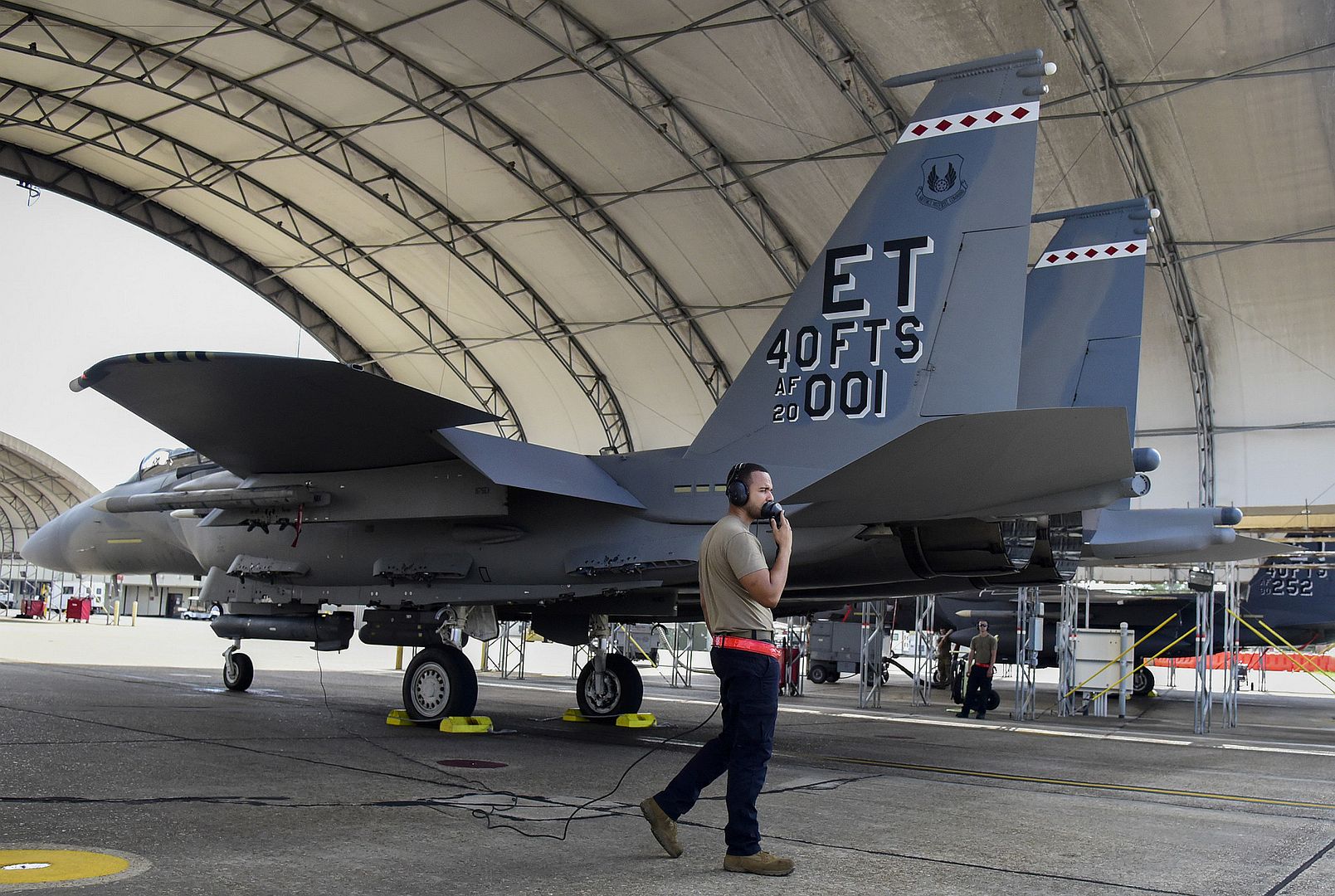
An F-15EX Eagle II pilot prepares for taxis for a sortie at Eglin Air Force Base
(U.S. Air Force photo/1st Lt. Karissa Rodriguez)
PACIFIC OCEAN (July 12, 2021) An EA-18G Growler, assigned to the "Gauntlets" of Electronic Attack Squadron (VAQ) 136, launches from the flight deck of the aircraft carrier USS Carl Vinson (CVN 70), July 12, 2021. Carl Vinson is currently underway conducting routine maritime operations in U.S. 3rd Fleet. (U.S. Navy photo by Mass Communication Specialist Seaman Isaiah Williams)
NEW DELHI, INDIA, July 13, 2021 – Boeing [NYSE:BA] is continuing to expand the Indian Navy’s long-range maritime reconnaissance anti-submarine warfare capabilities with the delivery of the country’s 10th P-8I. The patrol aircraft is an integral part of the Indian Navy’s fleet and has surpassed 30,000 flight hours since it was inducted in 2013.
This is the second aircraft to be delivered under an option contract for four additional aircraft that the Indian Ministry of Defence awarded in 2016. The Indian Navy was the first international customer for the P-8, which is also operated by the U.S. Navy, the Royal Australian Air Force and the United Kingdom’s Royal Air Force.
In addition to unmatched maritime reconnaissance and anti-submarine warfare capabilities, the P-8I has been deployed to assist during disaster relief and humanitarian missions.
Boeing supports India’s growing P-8I fleet by providing training of Indian Navy flight crews, spare parts, ground support equipment and field service representative support. Boeing’s integrated logistics support has enabled a high state of fleet readiness at the lowest possible cost.
Boeing is currently completing construction on the Training Support & Data Handling Centre at INS Rajali, Arakkonam, Tamil Nadu and a secondary maintenance training center at the Naval Institute of Aeronautical Technology, Kochi, Kerala as part of a training and support package contract signed in 2019. This new indigenous, ground-based training will allow Indian Navy crew to increase mission proficiency in a shorter time while reducing on-aircraft training time resulting in increased aircraft availability.
As a leading global aerospace company, Boeing develops, manufactures and services commercial airplanes, defense products and space systems for customers in more than 150 countries. As a top U.S. exporter, the company leverages the talents of a global supplier base to advance economic opportunity, sustainability and community impact. Boeing’s diverse team is committed to innovating for the future and living the company’s core values of safety, quality and integrity. Learn more at www.boeing.co.in.
WICHITA, Kan. (July 13, 2021) – Textron Aviation today announced its flagship Cessna Citation Longitude super-midsize business jet achieved certification from the European Aviation Safety Agency (EASA), clearing the way for customer deliveries to begin in the region.
The Cessna Citation Longitude super-midsize business jet is designed, produced and delivered by Textron Aviation Inc., a Textron Inc. (NYSE:TXT) company.
“In the second half of last year we saw a substantial increase in super-midsize flight activity across Europe as individuals relied on these products as a transportation solution,” said Tom Perry, vice president of Sales, EMEA, Textron Aviation. “The introduction of the Longitude to the European market will fulfil the international travel needs of many of our customers, while providing them peace of mind and convenience for both their business and personal travel.”
The largest jet in the Cessna Citation lineup, the Longitude was designed with business and return on investment at the forefront, with the lowest direct operating cost of any super-midsize jet. Capable of flying from Geneva to Dubai or Rome to New Delhi, the Longitude offers class-leading comfort, the quietest cabin in class, and advanced connectivity for those focused on staying productive in the air.
As a clean-sheet aircraft, the Longitude was designed with innovation front of mind, and a cabin experience shaped around customer input and a broad range of mission capabilities.
“The Longitude’s versatility has already enabled its utilization in multiple fields, from air ambulance to flight inspections,” added Perry. “We have one specially configured aircraft set to be delivered later this year, outfitted with flight inspection equipment to perform critical verification of navigation aids.”
The Longitude is backed by Textron Aviation’s extensive global customer service network, providing customers with direct access to nearly 3,000 expert employees, including service representatives offering maintenance, inspections, parts, repairs, avionic upgrades, equipment installations, refurbishments and other specialized services.
About the Cessna Citation Longitude
With a range of 6,482 kilometers (3,500 nautical miles) and full fuel payload of 726 kilograms (1,600 pounds), the Citation Longitude is designed to elevate passenger expectations in the super-midsize class by delivering the quietest cabin, a low cabin altitude (1,814 meters/5,950 feet), more standard features and a comfortable, bespoke interior. With seating for up to 12 passengers, including an optional crew jump seat, the Longitude features a stand-up, 6-foot tall flat-floor cabin. A standard double-club configuration delivers the most legroom in the super-midsize class. Fully berthable seats are designed and manufactured in-house, and a spacious walk-in baggage compartment is accessible throughout the entire flight. State-of-the-art cabin technology enables passengers to manage their environment and entertainment from any mobile device.
The clean-sheet design of the Longitude integrates the latest technology throughout the aircraft, bringing customers the lowest direct operating cost in its class. Powered by FADEC-equipped Honeywell HTF7700L turbofan engines with fully integrated autothrottles with envelope protection, the Longitude offers best in class maintenance intervals of 800 hr/18 months, Textron Aviation maintenance and diagnostic systems (AReS).
The spacious cockpit incorporates easier access and an ergonomic design that fully focuses on crew comfort and efficiency.
No super-midsize business jet offers more range, greater payload or higher cruise speed at a lower direct operating cost.
-
 Main AdminSCOTT AIR FORCE BASE, Ill. (AFNS) --
Main AdminSCOTT AIR FORCE BASE, Ill. (AFNS) --
Gen. Jacqueline Van Ovost, commander of Air Mobility Command, approved the Centerline Drogue System mission set as the KC-46A Pegasus’ first Interim Capability Release to meet joint force air refueling requirements, July 9.
This decision provides more daily “taskable” operational capabilities to the joint team and increases capacity for tanker fleet requirements.
“The last six months of operational use and programmatic evaluation indicate conditions have been met for ICR declaration of the Centerline Drogue System mission set,” Van Ovost said. “This decision reflects a risk-informed, data-driven, constraint-analyzed approach to releasing KC-46A operational capabilities to the joint force.”
Van Ovost announced the ICR plan in February as the command looks for ways to meet the joint force’s extensive aerial refueling requirements while the Air Force continues tanker recapitalization and divestiture efforts.
“This has required AMC to explore a variety of options or ‘tanker levers’ to relieve stress on today’s force,” Van Ovost said at the Air Force Association’s Air Warfare Symposium in February. “Increasing KC-46A operational use is the single largest lever available to bring additional air refueling capacity to meet joint force requirements as the tanker fleet is recapitalized to meet the needs of our combatant commanders.”
While the KC-46A is a maturing weapons systems with some operational restrictions, it now has proven capabilities that can be employed operationally for probe and drogue air refueling. The Air Force continues to conduct boom air refueling with fighter, bomber and transport aircraft for training, exercise, demonstration and familiarization missions before formally operationalizing the capability. The ICR concept provides a data-driven approach to certify these capabilities incrementally as the program moves toward full operational capability.
“ICR codifies for operational use what we’re already executing daily as the KC-46A makes progress on its initial operational test and evaluation, or IOT&E, plan,” Van Ovost said. “This is about bringing increased, predictable and taskable tanker capacity to the joint team today.”
In February, Van Ovost clarified there is no timeline associated with the ICR plan, which instead focuses on establishing confidence measures that allow the AMC commander and other senior leaders to qualitatively and quantitatively assess achievements in ICR milestones. If confidence measures are not met, then ICR on a particular mission set will not be declared.
While AMC seeks to provide increased operational capability to a stressed tanker fleet, Category-I deficiencies still need to be resolved, including the upgraded Remote Vision System 2.0 and a redesign of the Boom Telescope Actuator. The KC-46A will not achieve FOC until those deficiencies are cleared.
Although FOC is still years away, substantial progress continues.
“We’ve been simultaneously seasoning our aircrew and maintainers while identifying and wringing out deficiencies in the growing Pegasus fleet,” Van Ovost said. “We are flying and operating today with the KC-46A mission sets despite restrictions, including cross-ocean aerial refueling fighter movements, aeromedical evacuation missions, and cargo and passenger movements. The KC-46 is on a positive rate of climb!”
(U.S. Navy photo by Lt. Zach Fisher)
U.S. Marines and Sailors with 3d Battalion, 12th Marine Regiment, 3d Marine Division, and members of the Japan Ground Self-Defense Force, conduct medical evacuation training during Artillery Relocation Training Program 21.2 at Ojojihara Maneuver Area, Japan, July 13, 2021.
ARTP provides realistic, live-fire training opportunities to the only permanently forward-deployed artillery unit in the Marine Corps,
enabling them to provide precision indirect fires from a distributed environment in support of maritime operations. The unit in the Marine Corps, enabling them to provide precision indirect fires from a distributed environment in support of maritime operations. (U.S. Marine Corps photos by Lance Cpl.Diana Jimenez)
U.S. Air Force F-16 Fighting Falcons, assigned to the 112th Fighter Squadron, Ohio Air National Guard, take off from Alpena Combat Readiness Training Center, during the Global Information Dominance Experiment 3 in conjunction with the Architecture Demonstration and Evaluation 5 event before a flight at Alpena Combat Readiness Training Center, Alpena, Michigan, July 13, 2021. North American Aerospace Defense Command and U.S. Northern Command, in partnership with all eleven Combatant Commands, led the third in a series of Global Information Dominance Experiments designed to rapidly develop the capabilities required to increase deterrence options in competition and crisis through a data-centric software-based approach. GIDE events combine people and technology to innovate and accelerate system development for domain awareness, information dominance, decisional superiority, and global integration. The GIDE 3 experiment was executed in conjunction with the Department of the Air Force’s Chief Architect Office as part of their ADE 5 event, and the Joint Artificial Intelligence Center. (U.S. Air Force photos by Staff Sgt. Devin M. Rumbaugh)


Royal Air Force squadron leader Craig Docker with the combined air operations certification team, gives a thumbs up to a U.S. Air Force F-15C Eagle, assigned to the 493rd Fighter Squadron, during NATO Air Policing certification at Keflavik Air Base, Iceland, July 13, 2021. This year’s mission marks 60 years of NATO Air Policing across Europe and remains a fundamental component of how NATO provides security to its members. (U.S. Air Force photo by Staff Sgt. Rachel Maxwell)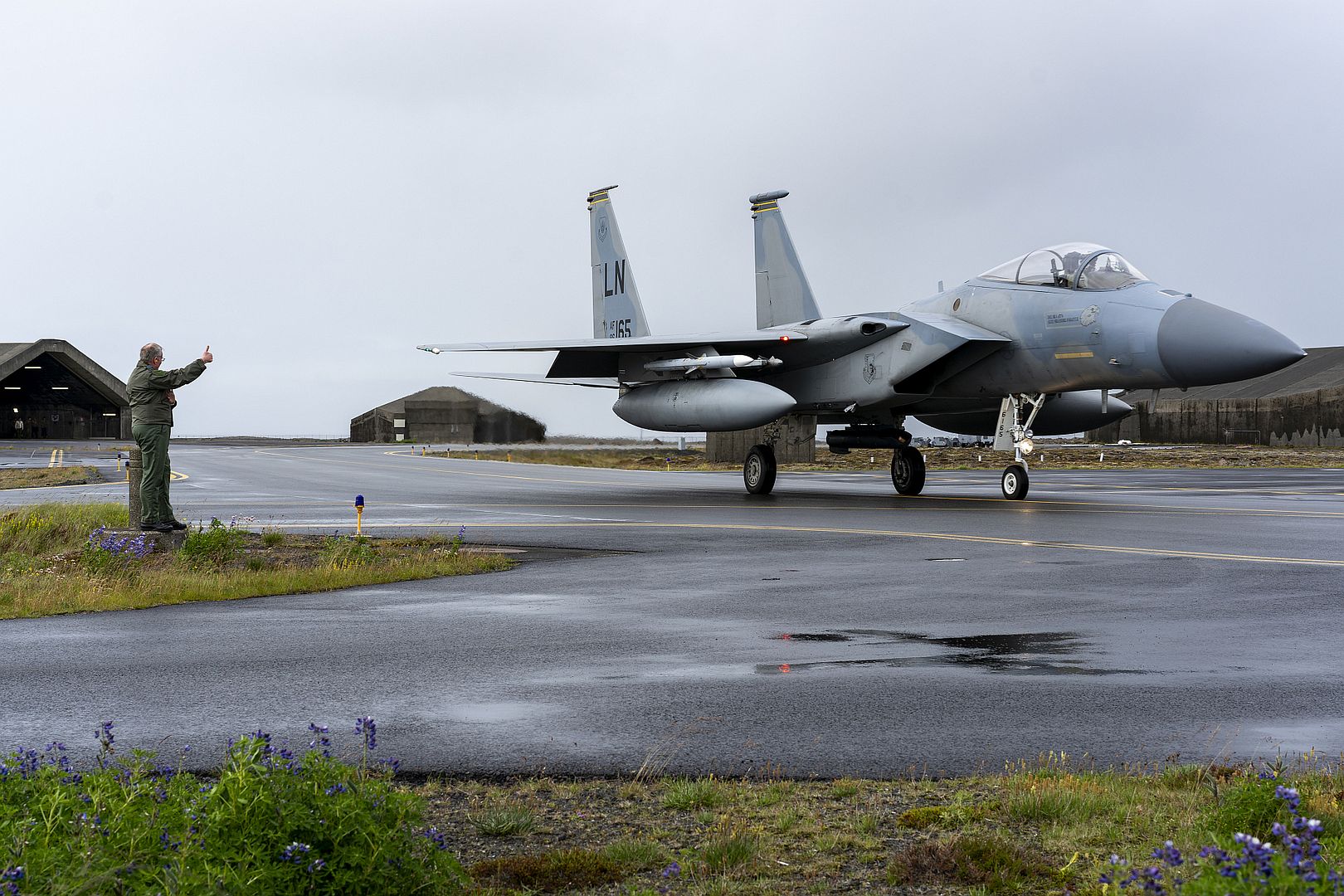
07.13.2021
Sailors assigned to the “Fighting Swordsman” of Strike Fighter Squadron (VFA) 32 park F/A-18F Super Hornets on the flight line during the squadron’s homecoming, on Naval Air Station (NAS) Oceana. VFA-32, part of Carrier Air Wing (CVW) 3 embarked on the Nimitz-class aircraft carrier USS Dwight D. Eisenhower (CVN 69), returns to NAS Oceana after a regularly scheduled deployment in support of maritime security operations and theater security cooperation efforts in U.S. 5th and 6th Fleet. (U.S. Navy photo by Mass Communication Specialist 3rd Class Jesus Aguiar/Released)
SOLOMON SEA (July 13, 2021) An F-35B Lighting II fighter aircraft from the 31st Marine Expeditionary Unit (MEU) launches off the flight deck of the forward-deployed amphibious assault ship USS America (LHA 6) during flight operations. America, flagship of the America Expeditionary Strike Group, along with the 31st Marine Expeditionary Unit, is operating in the U.S. 7th Fleet area of responsibility to enhance interoperability with allies and partners and serve as a ready response force to defend peace and stability in the Indo-Pacific region. (U.S. Navy photo by Mass Communication Specialist 3rd Class Matthew Cavenaile)
Colombian Air Force maintainers prepare to send off a Colombian Air Force Kfir assigned to Comando Aereo de Combate No.1 (CACOM 1) during Exercise Relampago VI at Comando Aereo de Combate Number 5 (CACOM 5) in Rionegro, Colombia, July 13, 2021. Colombian Air Force and United States Air Force aircraft will fly together and against one another in training using NATO standards to promote seamless interoperability. (U.S. Air Force photo by Senior Airman Duncan C. Bevan)
A Colombian Air Force Kfir assigned to Comando Aereo de Combate No.1 (CACOM 1) takes off during Exercise Relampago VI at Comando Aereo de Combate Number 5 (CACOM 5) in Rionegro, Colombia, July 13, 2021. Relampago VI provides joint training and improves readiness of U.S. and partner nation military personnel through interoperability training. (U.S. Air Force photo by Senior Airman Duncan C. Bevan)
JOINT BASE PEAR HARBOR HICKAM, Hawaii --
More than 35 aircraft and approximately 800 Airmen from Pacific Air Forces and Air Combat Command will deploy to the U.S. Indo-Pacific Command’s area of responsibility in July to participate in Operation Pacific Iron 2021.
Pacific Iron 2021 is a PACAF dynamic force employment operation to project forces into the USINDOPACOM’s area of responsibility in support of the 2018 National Defense Strategy (NDS) which called on the military to be a more lethal, adaptive, and resilient force.
Approximately ten F-15E Strike Eagles from the 389th Fighter Squadron, 366th Fighter Wing at Mountain Home Air Force Base, Idaho; approximately 25 F-22 Raptors from the 525th Fighter Squadron, 3rd Wing at Joint Base Elmendorf-Richardson, Alaska, and the 199th Fighter Squadron, 154th Wing, Hawaii Air National Guard at Joint Base Pearl Harbor Hickam, Hawaii; and two C-130J Hercules from the 374th Airlift Wing from Yokota Air Base, Japan will conduct combat dispersal operations in Guam and Tinian.
Airmen deployed in support of Pacific Iron 2021 will demonstrate Multi-capable Airmen skills and conduct simulated combat flight operations from local airports in Guam and Tinian. Fighters, mobility aircraft, Airmen and required support equipment will operate from Andersen AFB, A.B. Won Pat International Airport, and Northwest Field, Guam; and Tinian International Airport, Tinian, to conduct Agile Combat Employment operations. ACE is the use of agile operations to generate resilient airpower in a contested environment and is designed to organize, train and equip Airmen to be more agile in operation execution, strategic in deterrence, and more resilient in capabilities.
According to the 2018 NDS, dynamic force employment (DFE) allows for more flexibility in using ready forces to proactively shape the strategic environment while maintaining readiness to respond to contingencies and ensure long-term warfighting readiness.
( U.S. Air Force photo by Senior Airman Michael S. Murphy)
BALTIMORE – July 14, 2021 – Northrop Grumman Corporation (NYSE: NOC) has adopted Lean-Agile methodologies in the development and integration of the active electronically scanned array (AESA) AN/APG-83 Scalable Agile Beam Radar software for the F-16 Viper fighter aircraft. The transition to Lean-Agile was achieved in partnership with the U.S. Air Force development teams at Hill Air Force Base, Eglin Air Force Base and Air National Guard Air Force Reserve Command Test Center.
“With this collaborative relationship, we are now able to deliver software updates to be tested on the F-16 in weeks instead of the months it would have taken using the traditional waterfall method,” said Mark Rossi, director, SABR programs, Northrop Grumman. “Agile software development allows us to rapidly and affordably deliver capabilities to our customers – keeping F-16 operators ahead of their adversaries for decades to come.”
The AN/APG-83 features all-weather, high-resolution synthetic aperture radar mapping to present the pilot with a large surface image for more precise target identification and strike capabilities compared to legacy systems. Its design incorporates proven hardware and advanced operating modes from Northrop Grumman's fifth-generation F-35 AN/APG-81 and F-22 AN/APG-77 AESA radars. The high degree of commonality, shared manufacturing processes and infrastructure drives efficiencies and affordability improvements across all of Northrop Grumman's AESA radar programs.
The AN/APG-83 is an official program of record for both the U.S. Air Force’s active, Guard and Reserve components. The U.S. Air Force has achieved initial readiness requirements for SABR to meet a U.S. Northern Command Joint Emergent Operational Need (JEON) for homeland defense, and expects to formally declare full operational capability (FOC) after JEON fielding has completed in late 2021.
Northrop Grumman solves the toughest problems in space, aeronautics, defense and cyberspace to meet the ever evolving needs of our customers worldwide. Our 90,000 employees define possible every day using science, technology and engineering to create and deliver advanced systems, products and services.
July 14, 2021.
Bombardier and Sundt Air are pleased to announce the recent delivery of a brand-new Challenger 350 business jet. Sundt Air, an executive charter, aircraft management, and special mission company based in Norway, will manage the Challenger 350 business jet out of Oslo. The aircraft will be available for charter starting in July 2021.
“The Challenger 350 business jet allows passengers to remain comfortable, productive and well-rested as more people seek out safe and flexible alternative ways to travel,” said Peter Likoray, Senior Vice President, Sales, New Aircraft, Bombardier. “The iconic, market-leading Challenger 350 aircraft continues to be a top choice among the most discerning travellers.”
“As the largest operator of business jets in Norway, we are thrilled to add another Challenger 350 aircraft to our fleet,” said Tor Bratli, CEO, Sundt Air. “Our customers appreciate the Challenger 350 jet’s ideal combination of optimal performance and superior cabin comfort.”
From Western Europe, the Challenger 350 business jet can take eight (8) passengers nonstop all the way to North America or fly from Oslo to Dubai. Its runway agility enables it to operate from highly sought-after European destinations such as Lugano and Cannes and from short runways, such as in Gstaad, Switzerland. In 2019, the Challenger 350 aircraft successfully completed a record speed flight from Gstaad to Malaga, Spain, completing the mission in two (2) hours and four (4) minutes at an average cruise speed of Mach 0.82. The Challenger 350 aircraft is also certified for steep approach into London City Airport.
A force in the business jet industry, the Challenger 350 aircraft strengthens its position year after year with enhancements and upgrades to its winning combination of performance and cabin experience. Among pilots, the Challenger 350 aircraft is recognized as being agile, reliable and a pleasure to fly. The Challenger 350 aircraft was the most-delivered business jet in the Medium category in 2020, making it the category leader for a seventh consecutive year. Paired with impressive high-performance attributes, the Challenger 350 aircraft is designed to access challenging airfields, climb faster and cruise efficiently while providing a smooth ride.
Sundt Air is the largest business aircraft operator in Norway and manages one of the newest and largest fleets of light, midsize and super-midsize aircraft in Europe. The Challenger 350 business jet continues to take centre stage as the preferred choice for Sundt Air’s luxury travel experiences.
Post a reply
- Go to Next topic
- Go to Welcome
- Go to Introduce Yourself
- Go to General Discussion
- Go to Screenshots, Images and Videos
- Go to Off topic
- Go to Works in Progress
- Go to Skinning Tips / Tutorials
- Go to Skin Requests
- Go to IJAAF Library
- Go to Luftwaffe Library
- Go to RAF Library
- Go to USAAF / USN Library
- Go to Misc Library
- Go to The Ops Room
- Go to Made in Germany
- Go to Campaigns and Missions
- Go to Works in Progress
- Go to Juri's Air-Raid Shelter
- Go to Campaigns and Missions
- Go to Works in Progress
- Go to Skinpacks
- Go to External Projects Discussion
- Go to Books & Resources
